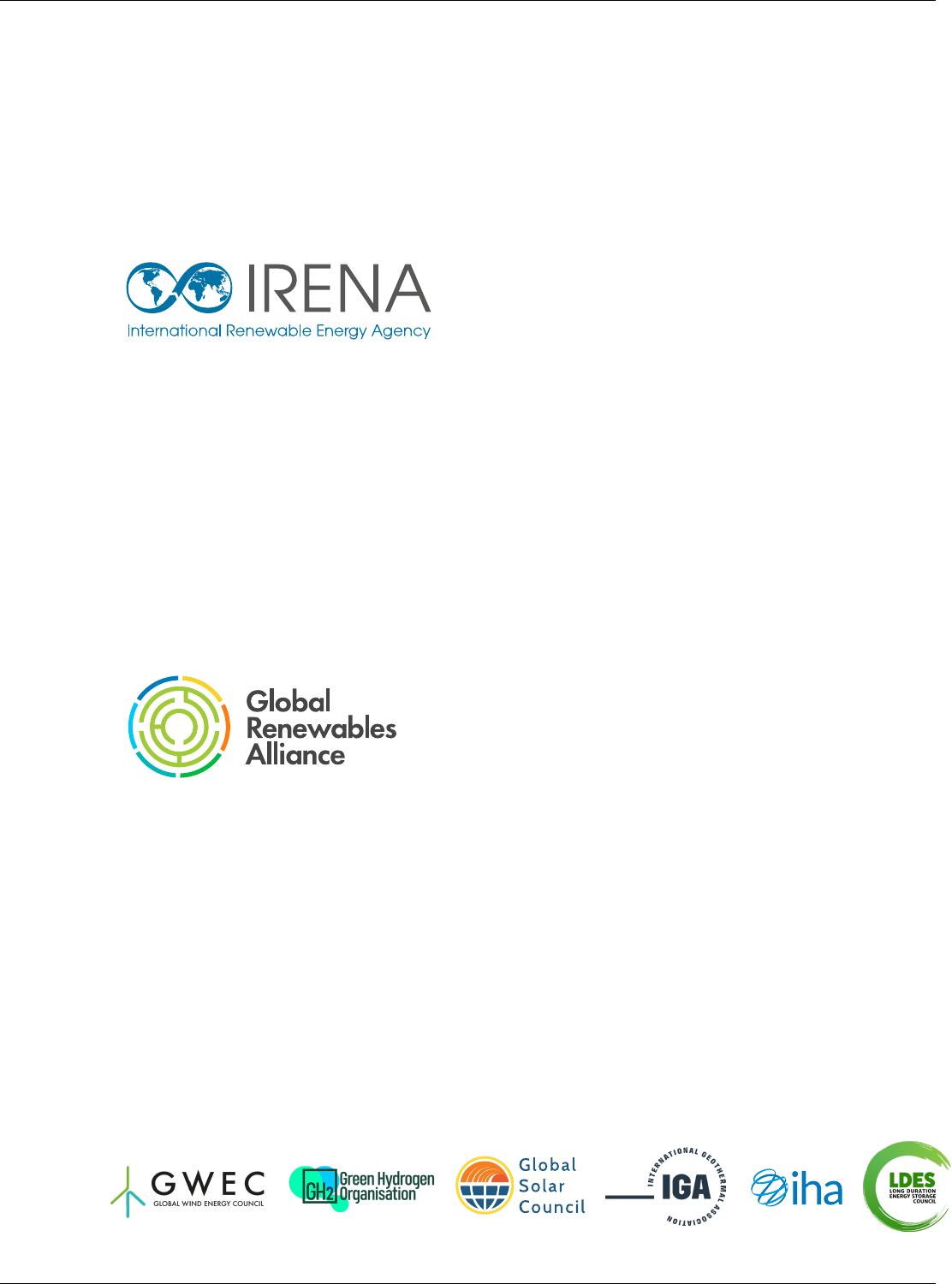GlobalRenewablesAllianceTRIPLINGRENEWABLEPOWERANDDOUBLINGENERGYEFFICIENCYBY2030CRUCIALSTEPSTOWARDS1.5°C2030TRIPLINGRENEWABLEPOWERANDDOUBLINGENERGYEFFICIENCYBY2030PREFACESincetheRioEarthSummitandtheadoptionoftheUnitedNationsFrameworkConventiononClimateChange(UNFCCC)in1992,theConferenceofthePartiestotheConvention(COP)hasconvenedsignatoryPartieseachyeartodetermineambitionsandresponsibilities,andidentifyandassesstheprogressofclimatemeasures.The21stsessionoftheCOP(COP21)ledtotheParisAgreement,whichmobilisedcollectiveactiontolimittheincreaseinglobalaveragetemperaturetowellbelow2°Cabovepre-industriallevels,pursueeffortstolimitthetemperatureincreaseto1.5°Cabovepre-industriallevels,andstrengthentheglobalresponsetothethreatofclimatechange.COP28,andthefirstGlobalStocktakeoftheParisAgreement,canbetheturningpointonclimateactionoverthiscriticaldecadetoaccelerateatransitionthatputseconomiesonthepathtowardanewlow-carbon,high-growth,sustainableeconomicmodelinawaythatisbothtransformationalandjust.COP28hasthevisiontodeliveronthepillarsoftheParisAgreement,focusingonspecificactiononfourparadigmshifts:•fast-trackingtheenergytransitionandslashingemissionsbefore2030;•�transformingclimatefinance,bydeliveringonoldpromisesandsettingtheframeworkforanewdealonfinance;•puttingnature,people,livesandlivelihoodsattheheartofclimateaction;and•mobilisingforthemostinclusiveCOPever.2©DarylHan/unsplashCRUCIALSTEPSTOWARDS1.5°CTheInternationalRenewableEnergyAgency(IRENA)isanintergovernmentalorganisation,comprising168MemberStatesandtheEuropeanUnion,thatsupportscountriesintheirtransitiontoasustainableenergyfuture.IRENAservesasacentreofexcellence;arepositoryofpolicy,technology,resourceandfinancialknowledge;andtheprincipalplatformforinternationalco-operationonrenewableenergy.IRENApromotesthewidespreadadoptionandsustainableuseofallformsofrenewableenergy,includingbioenergy,geothermal,hydropower,ocean,solarandwindenergy,inthepursuitofaglobalenergytransitionthatdeliverssustainabledevelopment,energyaccess,energysecurityandlow-carboneconomicgrowthandprosperity.www.irena.orgTheGlobalRenewablesAlliance(GRA)representstheleadinginternationalindustryassociationsacrossrenewableenergyandservesasaunifiedrenewableenergyvoiceonaglobalscale.Thealliancewasestablishedin2022andcomprisesfoundingmembers,theGlobalWindEnergyCouncil,theGlobalSolarCouncil,theInternationalHydropowerAssociation,theInternationalGeothermalAssociation,theLongDurationEnergyStorageCouncilandtheGreenHydrogenOrganisation.TheGRA’smissionistoincreaseambitionandacceleratetheuptakeofrenewableenergyacrosstheworld,inlinewithacredible1.5°Cpathway.Assuch,itcollaboratesandcommunicateswithgovernments,investors,civilsocietyandotherkeystakeholdersoncollectiveactionswhichcanenablethebroadscale-upofrenewableenergy.Whileeachcountryandregionwilladoptanationallydeterminedapproachtotheenergytransition,theGRAadvocatesfortheaccelerationofwind,solar,hydroandgeothermalpower,andessentialtechnologieslikelong-durationstorageandgreenhydrogen.Thiswillensurethatfutureglobalenergysystemsarenotonlyclean,butsecureandjust.www.globalrenewablesalliance.org/3©SzilardToth/shutterstockTRIPLINGRENEWABLEPOWERANDDOUBLINGENERGYEFFICIENCYBY2030DISCLAIMERANDACKNOWLEDGEMENTSThispublicationandthematerialhereinareprovided“asis”.Allreasonableprecautionshavebeentakenbythecopyrightholderstoverifythereliabilityofthematerialinthispublication.However,neithertheCOP28Presidency,IRENA,GRA,noranyoftheirofficials,agents,dataorotherthird-partycontentprovidersprovidesawarrantyofanykind,eitherexpressedorimplied,andtheyacceptnoresponsibilityorliabilityforanyconsequenceofuseofthepublicationormaterialherein.TheinformationcontainedhereindoesnotnecessarilyrepresenttheviewsofallMembersofIRENAortheGRAanditsconstituentassociations.ThementionofspecificcompaniesorcertainprojectsorproductsdoesnotimplythattheyareendorsedorrecommendedbytheCOP28Presidency,IRENAortheGRAinpreferencetoothersofasimilarnaturethatarenotmentioned.ThedesignationsemployedandthepresentationofmaterialhereindonotimplytheexpressionofanyopiniononthepartoftheCOP28Presidency,IRENAortheGRAconcerningthelegalstatusofanyregion,country,territory,cityorareaorofitsauthorities,orconcerningthedelimitationoffrontiersorboundaries.4CRUCIALSTEPSTOWARDS1.5°C©COP28,IRENAandGRA,2023Unlessotherwisestated,materialinthispublicationmaybefreelyused,shared,copied,reproduced,printedand/orstored,providedthatappropriateacknowledgementisgiventotheauthororganisationsasthesource(s)andcopyrightholders.Materialinthispublicationthatisattributedtothirdpartiesmaybesubjecttoseparatetermsofuseandrestrictions,andappropriatepermissionsfromthesethirdpartiesmayneedtobesecuredbeforeanyuseofsuchmaterial.Citation:COP28,IRENAandGRA(2023),Triplingrenewablepoweranddoublingenergyefficiencyby2030:Crucialstepstowards1.5°C,InternationalRenewableEnergyAgency,AbuDhabi.ISBN:978-92-9260-555-1AcknowledgementsThisreportistheresultofacollaborationbetweentheCOP28Presidency,theInternationalRenewableEnergyAgencyandtheGlobalRenewablesAlliance.ThereportdrawsextensivelyontheanalysispresentedinIRENA’sWorldEnergyTransitionsOutlook2023:1.5°CpathwayandseveralotherIRENAreports,complementedbyvariousreportspublishedbythemembersoftheGRA.Thereportwasco-ordinatedandcompiledby:FrancisField,UteCollier,RicardoGorini,YongChen,DialaHawila,MichaelTaylorandFaranRana(IRENA);JoyceLeeandReshmiLadwa(GWEC);BruceDouglasandBeniaminStrzelecki(GRA);andHarleyHigginsWatsonandYasinKasirga(COP28).ValuableinputsandreviewwereprovidedbyRolandRoesch,RabiaFerroukhi,ElizabethPress,NicholasWagner,MengzhuXiao,SeanCollins,StutiPiya,GerardoEscamilla,RodrigoLeme,FransiscoBoshell,ArinaAnisie,GayathriPrakash,IsalineCourt,IlinaRadoslavovaStefanovaandPaulKomor(IRENA);AdnanZ.Amin(COP28);BenBackwell(GWEC);JuliaSouder,AlexCampbellandGabeMurtaugh(Long-DurationEnergyStorageCouncil);MátéHeisz,AbdallahAlshamaliandAlyssaPek(GlobalSolarCouncil);AntonioArruebo,JonathanGorremansandRaffaeleRossi(SolarPowerEurope);DebbieGrayandRebeccaEllis(InternationalHydropowerAssociation);JonasMobergandSimranSinha(GreenHydrogenOrganisation);MohamedJameelAlRamahiandNikolasMeitanis(Masdar).ThereportwasdevelopedwiththesupportoftheBostonConsultingGroup.TheauthorswishtothankRichLesser,MichelFredeau,PattabiSeshadri,TamerObied,VishalMehta,LarsHolm,AliHoujeij,MariaAgostiniandSashaRiser.CommunicationsanddigitalisationsupportwereprovidedbyNicoleBockstaller,DariaGazzolaandManuelaStefanides(IRENA);theCOP28Communicationsteam;andAlexanderBath(GRA).ThereportwasproducedbyIRENA,withgraphicdesignbyweeks.deWerbeagenturGmbH.5TRIPLINGRENEWABLEPOWERANDDOUBLINGENERGYEFFICIENCYBY2030CONTENTSForewords.......................................08TRIPLINGUP,Introduction....................................15DOUBLINGDOWNRENEWABLEPOWERANDENERGYEFFICIENCYIMPROVEMENTSTO2030.............18x3RENEWABLEPOWER............................19ENERGYEFFICIENCY.............................28x2Idee01a©DianaParkhouse/unsplash2030DOUBLINGENERGYTODAYx2EFFICIENCYx3TRIPLINGRENEWABLEPOWER©MAGNIFIER/shutterstock©AgnieszkaSwierczek/unsplash6CRUCIALSTEPSTOWARDS1.5°C©MarcelPoncu/shutterstockENERGYTRANSITIONCONCLUSIONENABLERSFROMAMBITIONTOACTION..57ANDPOLICYPRIORITIES.........30References.......................................................60INFRASTRUCTUREANDSYSTEMOPERATION...............................................31©MarcelPoncu/shutterstockPowergrids................................................33Energystorage...........................................34�End-useelectrificationandsectorcoupling.....................................................36Demand-sidemanagement.......................38POLICYANDREGULATION........................39Improvingenergyefficiency.......................41Marketincentivesandfiscalpolicy.............42Powermarketdesignandregulation.........44Streamliningpermitting.............................46Reducingnegativeimpacts;maximisingsocialandenvironmentalbenefits.............47SUPPLYCHAINS,SKILLSANDCAPACITIES...............................................49Buildingresilientsupplychains..................49Education,trainingandcapacity-building......................................................50SCALINGUPPUBLICANDPRIVATEFINANCE....................................................52Enhancinginternationalcollaboration.......557TRIPLINGRENEWABLEPOWERANDDOUBLINGENERGYEFFICIENCYBY2030©DianaParkhouse/unsplashFOREWORDS8CRUCIALSTEPSTOWARDS1.5°CDrSultanAlJaberCOP28President-DesignateTriplingthedeploymentofrenewablepowergenerationanddoublingenergyefficiencyareamongstthemostimportantleverstocutgreenhousegasemissions.Theworldhasalreadymadegreatstridesbyexpandingglobalrenewableenergycapacityandbecomingmoreenergyefficient;butprogresssofarhasbeentooslow.TheGlobalStocktakehastoldusexactlyhowfarofftrackweare.Weneedtocut22gigatonnesofgreenhousegasesinthenext7yearsinordertokeep1.5°Cwithinreach.Thephase-downoffossilfuelsisinevitableandessential,butitmustberesponsible.Todeliverajustandorderlyenergytransitionwhileadvancingsocio-economicdevelopmentandensuringenergyaffordability,reliabilityandsustainability,wemustrapidlyaccelerateoureffortstorampuprenewableenergy.Nowisthetimetoturbochargesolutionsandmeettheurgencyofthemomentwithambitiousanddeterminedaction.AheadofCOP28,wearebuildingglobalmomentumandconsensusinsupportofourtargettotripleglobalrenewablepowergenerationanddoubleenergyefficiency.Thisreportoutlinesactionablesolutionsthatcanenabletheprogressweneedanddemonstratesthatthistargetisambitiousbutachievable.Iamnowcallingoneveryonetocometogether,committocommontargets,andtakecomprehensivedomesticandinternationalaction,asoutlinedinthisreport,tomakeourambitionsareality.9TRIPLINGRENEWABLEPOWERANDDOUBLINGENERGYEFFICIENCYBY2030FrancescoLaCameraDirector-General,InternationalRenewableEnergyAgencyOurmissionisasclearasitisurgent:tokeepthe1.5°Ctargetwithinreach,wemusttriplerenewablepowercapacityanddoubleenergyefficiencyby2030.IRENA’sWorldEnergyTransitionsOutlook,whichprovidestheanalyticalfoundationforthisreport,warnsthattheenergytransitionisdangerouslyoff-track,demandingimmediate,radicalcollectiveaction.Asignificantaccelerationofrenewableenergydeployment,coupledwithtangibleprogressinenergyefficiencyandend-useelectrification,isessentialtoputtheworldbackontracktoachievethegoalsoftheParisAgreement.Thiswillrequireconcertedactiontourgentlyaddressdeeplyentrenchedsystemicbarriersacrossinfrastructure,policyandinstitutionalcapacitiesstemmingfromsystemsandstructurescreatedforthefossil-fuelera.Wemustnowfocusonbuildingthenecessaryinfrastructureandinvestingatscaleingridstoaccommodateagrowingshareofrenewableenergy;establishpolicyandregulatoryarchitecturethatcanfacilitatetargetedpublicandprivatesectorinvestmentsintheenergytransition;andstrategicallyrealigninstitutionalcapacitiestohelpensureskillsandcapabilitiesmatchtheenergysystemofthefuture.Thisisespeciallyimportantfordevelopingcountries,wherewemustdeliveronourcommitmentstosustainabledevelopment,ensuringnooneisleftbehind.COP28markstheyearofthefirstGlobalStocktake,inwhichtheworldreflectsonitsprogressinimplementingtheParisAgreement.Itisvitalthatcollectiveactionbegalvanisedfollowingthiskeymilestoneinourjourneytowardaclimate-safeexistencetoensuretheforthcomingroundofNationallyDeterminedContributionsin2025representsatransformativeleapforward,realigninguswiththe1.5°Cgoal.Thisreportoutlinestheessentialactionsgovernmentsmustprioritisetoachievethisobjective.10CRUCIALSTEPSTOWARDS1.5°CBruceDouglasChiefExecutiveOfficer,GlobalRenewablesAllianceThisisthe‘makeorbreak’decadetoavoidthemostcatastrophicimpactsofclimatechange.Aglobalenergytransitionthatacceleratesrenewableenergyandphasesoutfossilfuelsistheonlywaytobuildaclean,secureandjustfuture.Doubledown,tripleup:Triplingglobalrenewableenergycapacityanddoublingenergyefficiencyratesby2030arethemostimpactfulcommitmentswecanundertakenowtoachievea1.5°Cpathway.Thiswoulddelivercleanerelectricitysystems,accesstoaffordableenergyandgreenjobsformillionsofpeople,billionsofdollarsinpublicandprivatecapitaltofosterclimate-resilientgrowth,andreducelossanddamagefornatureandpeoplewroughtbyharmfulclimatechange.Toachievethesetargets,weneedtodramaticallyrampupwindpower,solarpower,hydropowerandgeothermalpower.Thiswouldsetthestagetoscalelong-durationenergystorageandgreenhydrogen,ensuringenergysystemsarenotjustclean,butsecureandresilient.Onaverage,1000GWofrenewablesneedstobeinstalledeachyearfortherestofthedecadetobringtotalrenewablescapacityto11000GWby2030.Asthegrowthcurvewillriseoverthecourseofthedecade,therenewablesindustrybelievesatleast1500GWofrenewablescapacitycouldbeinstalledin2030alone.GloballeadersmustcommittothesetargetsatCOP28.However,progresstowards2030goalscannotbetakenforgranted.Policymakersmustworkhand-in-handwithindustryandcivilsocietytourgentlyimplementtheenablingactionsinthisreport,centredon:infrastructureandsystemoperation;policyandregulation;andsupplychains,skillsandcapacities.Critically,theseareasmustbereinforcedbylow-costfinancingandinternationalcollaboration.Thisisaunique”onceinageneration“opportunity,butweneedurgentactiontoscalerenewableenergyineveryregionoftheworld.Onlythencanweprotecttheplanetandsecurealiveablefutureforall.11TRIPLINGRENEWABLEPOWERANDDOUBLINGENERGYEFFICIENCYBY2030KEYRECOMMENDATIONSTOTALGLOBALRENEWABLEPOWERGENERATIONCAPACITYWILLNEEDTOTRIPLEBY2030toreachmorethan11000GWunderIRENA’s1.5°CScenariointheWorldEnergyTransitionsOutlook,withsolarphotovoltaic(PV)andwindpoweraccountingforabout90%ofrenewableenergycapacityadditions.ENERGYEFFICIENCYIMPROVEMENTSMUSTDOUBLEBY2030TOREMAINONA1.5°CPATHWAY.InIRENA’s1.5°CScenariothiswillbedrivenbyacombinationofefficienttechnologiesinend-usesectorsandextensiveelectrification.ThesevitalmilestonesmustbeachievedtokeeptheglobalenergytransitionontracktomeetParisAgreementgoals.ACOMPREHENSIVEMIXOFPOLICIESISNEEDEDTOACHIEVETHESEAMBITIOUSTARGETS.Asidefromdeploymentandenablingpolicies,structuralchangeisneededtoensurethetransitiontoanenergy-efficienteconomyandarenewables-basedpowersystemisjustandfair,andprovidesbenefitsforall.ENERGYEFFICIENCYPOLICYMEASURESshouldinclude:theadoptionoftargetswithspecifictimehorizons;strongregulatoryframeworksincludingbuildingcodesandenergyefficiencystandardsforappliances;fiscalandfinancialincentives;andpubliccampaignstobuildawarenessoftheroleofenergyefficiencymeasures,publictransportandgreenmobilityforcostsavingsandcollectivedecarbonisationgoals.12CRUCIALSTEPSTOWARDS1.5°CRENEWABLEENERGYDEPLOYMENTREQUIRESENABLINGMEASURESTHATGOBEYONDREGULATIONSORFISCALANDFINANCIALINCENTIVES.Theorganisationalstructuresofpowersectorsmustbereshapedtointegrateahighershareofrenewables.Procurementmechanismsmustbedesignedinawaythatstrengthensvaluechainsandtrade,andindustrialpoliciesmustbefitforbuildingresilientsupplychains.Education,training,re-skillingandup-skillingshouldbeprioritised;womenandunder-representedgroupsmustbeempowered;andcollaborationbetweenindustry,civilsociety,policymakersandotherkeystakeholdersshouldbeencouraged.EXISTINGELECTRICITYINFRASTRUCTURESHOULDBEEXPANDEDANDMODERNISEDTOCREATEANEWENERGYSYSTEMFITFORRENEWABLES.Thereisanurgentneedtoboostcross-sectorinfrastructureplanning,increasecross-borderco-operationanddevelopregionalpowergrids.Actionisalsoneededtodrivegridmodernisationandexpansionandensuresupply-sideflexibilityanddemand-sidemanagement.RENEWABLEPOWERCAPACITYSHOULDBEINCREASEDMORERAPIDLYINDEVELOPINGCOUNTRIES,giventheirgrowingelectricitydemandandtheimportantroleofrenewablesinaddressingthesignificantenergyaccessdeficitinthesecountries.WEMUSTRAPIDLYMOBILISEPUBLICANDPRIVATEFINANCETOTRIPLERENEWABLEPOWERCAPACITYANDDOUBLEENERGYEFFICIENCY.AnnualaverageinvestmentinrenewablepowergenerationmustreachUSD1300billionby2030,comparedto486billionin2022.Inthedevelopingworld,wemustminimiseinvestmentrisksandprovideaccesstolow-costfinancing.TheglobalfinancialarchitecturemustbereformedtosupporttheenergytransitionintheGlobalSouth.Climate-relatedfundingfrommultilateraldevelopmentbanksmustberampedup,andpubliccapitalshouldberedirectedfromthefossilfuelssectortorenewableenergy.THISWILLREQUIRESTRONGINTERNATIONALCOLLABORATION.Immediateeffortsarerequiredtofacilitateandcontributetomultilateralinitiativesthatpromoteknowledgesharingandcapacitybuildingtodeliverajusttransitionwhilstalsosafeguardingnatureandbiodiversity.Collaborationisurgentlyrequiredtofostercollectiveactionongovernance,climatefinanceandinnovation.North-SouthandSouth-Southdialoguesshouldbecultivated;groupsliketheG7andG20mustmobilisesupportandinvestment;andjusttransitionfundsshouldbeestablishedandoperationalisedinemergingeconomies.13©Curioso.Photography/shutterstockTRIPLINGRENEWABLEPOWERANDDOUBLINGENERGYEFFICIENCYBY203014CRUCIALSTEPSTOWARDS1.5°CINTRODUCTIONTheUnitedNationsIntergovernmentalPanelonClimateChange(IPCC),initslatestAssessmentReport(AR6),sentaclearmessagetotheworldthatthisdecadeiscriticaltooursuccessinlimitingglobalsurfacetemperatureincreaseto1.5°Cabovepre-industriallevelsbytheendofthiscentury(IPCC,2023).Thereisanurgentneedforrapidandimmediateactiontoreduceglobalnetanthropogeniccarbondioxide(CO2)emissionsbyalmost50%from2019levelsby2030,withasignificantproportionofthisreductionoccurringwithinthefieldofenergy.However,theenergytransitionremainsoff-trackandglobalgreenhousegasemissionshavereachedrecordlevels.IRENA’sflagshipreport,WorldEnergyTransitionsOutlook2023:1.5°Cpathway,showsthatevenifcurrentpledgesandplansmadebynationalgovernments–includingNationallyDeterminedContributions(NDCs),long-termlowgreenhousegasemissiondevelopmentstrategies(LT-LEDS)andothercommitments–arefullyimplemented,thiswouldservetoreduceCO2emissionsbyonly6%in2030comparedto2022levels.Thisisfarbelowtheemissionreductionsrequiredtoplacetheworldona1.5°Cpathway.Themessageisclear:wecannotlimitglobalsurfacetemperatureincreaseto1.5°Cabovepre-industriallevelsbytheendofthiscenturywithoutrapid,sustainedandconcertedaction.COP28markstheyearofthefirstGlobalStocktake(GST),throughwhichpolicymakers,industry,financialinstitutions,civilsocietyandotherstakeholderswillreflectontheprogressachievedinimplementingclimatepledgessincetheadoptionoftheParisAgreementin2015.TheWorldEnergyTransitionsOutlook2023concludesthatasignificantaccelerationinthedeploymentofrenewableenergy,energystorageandrenewablefuels,coupledwithtangibleprogressinenergyefficiencyandelectrificationofend-usesectors,arerequiredtoputtheworldbackontrackinthisdecadetomeetglobalclimategoals(IRENA,2023a).11)Areductionintheuseoffossilfuelsforpowergeneration-particularlyincarbon-intensivegenerationfleetswithoutabatementmeasures-isvitaltothesuccessoftheenergytransition,albeitbeyondthescopeofthisreport.By2030,fossil-firedelectricitygenerationwouldfallbyaround47%fromthe2022level,whilecoal-and-oil-basedgenerationwouldfalltozerobymid-century,undertheIRENA1.5°CScenario(IRENA,2023a).15TRIPLINGRENEWABLEPOWERANDDOUBLINGENERGYEFFICIENCYBY2030©zorazhuang/iStockTheglobalenergytransitionrequiresasignificantreductionincarbonemissionsacrosstheentireenergyindustry,aswellasinend-usesectors.Leveraginglow-costsolarPV,onshoreandoffshorewind,andotherrenewableelectricitygenerationsources,thepowersectormustleadthewayassolutionsinothersectorsscaleup.Acceleratingtheprogressofthetransitionworldwiderequiresaholisticapproach,backedbysystemicinnovationtotransformexistingstructuresandsystemsbuiltforthefossilfuelera.Whilstthephasedownoffossilfuelsisbothessentialandinevitable,itmustalsoberesponsible.Thetransitionneedstobedeliveredinawaythatensuresenergysecurity,accessibilityandaffordability,whilealsosustainingsocio-economicdevelopmentandadoptingnature-positiveapproaches.Thespeedatwhichthetransitionisachievedwillbedeterminedbyhowquicklyzero-carbonalternativescanbeintroducedandscaledup.Greaterambitionandstrongercollectiveactionareimmediatelyrequiredtoaccelerateprogress,particularlyinrenewableenergyandenergyefficiency.Againstthisbackdrop,policymakers,energyauthorities,industryandcivilsocietyhaveanopportunitytoalignatCOP28toagreeglobaltargetstotriplerenewablepowergenerationcapacityanddoubletheenergyefficiencyimprovementrateby2030.Thesegoalsrepresentsomeofthemostimportantleversforchangetoadvancetheenergytransitionthisdecade.Thisreportconsolidateshigh-levelanalysisofthesetargets,detailingexistingshortfallsandidentifyingkeyenablerstoresolvethem.Itrepresentsglobalperspectiveswithintherenewableenergyandclimatechangespace,withtheCOP28Presidency,theInternationalRenewableEnergyAgency(IRENA)andtheGlobalRenewablesAlliance(GRA)unitingtoprovideconcreterecommendationsonthemeanstomeettheserenewablepowerandenergyefficiencytargets.Thesolutionspresentedaretechnologicallymature,cost-competitiveandcommerciallyavailable,andcanbescaleduprapidlyinmostcountriesaroundtheworld;indeed,utility-scalesolarPVandonshorewindarealreadythemostcost-competitivesourcesofnewelectricitysupplyinmostcountriestoday(IRENA,2023b).Acceleratingprogressinrenewableenergydeploymentandenergyefficiencyimprovementmeasuresthisdecadewouldcontributetoacleanerenergysystem,improveenergysecurityandreduceexposure–bothinindustryandforconsumers–tothedamagingrisksofhighlyvolatilefossilfuelprices.Itwouldalsoimproveairqualityandreducehealthcosts;deliveruniversalaccesstocleanaffordableenergy;andprovidegreatercollectivesecurityandwell-being.Withtherightpoliciesinplace,theglobalenergytransitionwillalsobringextensivesocio-economicbenefits,includingintheformofjobcreationandincomegeneration.16Idee01a2030CRUCIALSTEPSTOWARDS1.5°Cx3TRIPLINGTODAYDOUBLINGENERGYRENEWABLEPOWERx2EFFICIENCYThekeyenablingframeworks,policiesandrecommendationsdetailedinthisreportprovideconcreteadvicetogovernmentsaroundtheworldonthenecessarystepsrequiredbetweennowand2030tomeetthesetargets.Realisingthetargets,inaccordancewithIRENA’s1.5°CScenario,wouldrequireacumulativeglobalinstalledrenewableelectricitygenerationcapacityofover11000GW,andadoublingoftheannualenergyefficiencyimprovementratefromthecurrentlevelby2030(IRENA,2023a).ItisessentialthatgloballeadersconveningatCOP28demonstratethecollectivewilltosetanewpaceforactionthisdecadebycommittingtothesetargets;inshort,thisisacriticalstepinacriticaldecadetokeepthe1.5°Ctargetwithinreach.Thiswillrequireacceleratedactionsinmanyareas,inparticularmodernisingandexpandingphysicalenergyinfrastructure;improvingpowersystemoperations;establishingtherightpoliciesandregulatoryframeworks;buildingresilientsupplychains;anddevelopingskillsandinstitutionalcapacities.Theseactionsmustbeunderpinnedbyasignificantincreaseinpublicandprivatefinancing,particularlytosupportthedevelopingworld.Toensuretheenergytransitionisbothjustandinclusive,greaterinternationalcollaborationisalsoneeded.Worldwide,around675millionpeoplestilllackaccesstoelectricityand2.3billionlackaccesstocleancookingmethods(IEAetal.,2023).ProvidingrenewableenergytothosepopulationswouldcontributesignificantlytoachievingSustainableDevelopmentGoal7toEnsureaccesstoaffordable,reliable,sustainableandmodernenergyforall.17©MAGNIFIER/shutterstockTRIPLINGRENEWABLEPOWERANDDOUBLINGENERGYEFFICIENCYBY2030RENEWABLEPOWERx3ENERGYEFFICIENCYx218CRUCIALSTEPSTOWARDS1.5°CTRIPLINGUP,DOUBLINGDOWNRENEWABLEPOWERANDENERGYEFFICIENCYIMPROVEMENTSTO2030RENEWABLEPOWER3xOursuccessinreducinggreenhousegasemissionsthisdecadewilldeterminewhetherglobaltemperaturerisecanbelimitedto1.5°C.AccordingtoIRENA’sWorldEnergyTransitionsOutlook2023,globalenergy-relatedCO2emissionswouldneedtodeclinesignificantlyto23gigatonnesofCO2(GtCO2)in2030,fromtherecordhighof36.8GtCO2in2022(IRENA,2023a).IRENA’s1.5°CScenarioidentifiesatechnicallyandeconomicallyfeasiblepathwaytoanenergyfuturethatisconsistentwithParisAgreementgoals.Itconcludesthatenergyefficiencyandelectrificationpoweredbyrenewables,cleanhydrogenanddirectuseofrenewablesaredrivingthetransition;butthesheerscaleandextentofthistransitionrequiresarapidandsystemictransformationoftheenergysystem.Despitetheprogressachievedtodate,thecurrentdeploymentofenergytransitiontechnologiesisinsufficientinspeedandscaletoachievetheParisAgreementgoals.Theenergytransitionrequiresanurgentandsignificantaccelerationacrossenergysupply,end-usesectorsandenablingtechnologies-particularlythedeploymentofrenewablepowergenerationsystemsinmorecountriesandregions.19TRIPLINGRENEWABLEPOWERANDDOUBLINGENERGYEFFICIENCYBY2030©Sanwenyu1/iStockBy2030,globaltotalinstalledrenewablepowergenerationcapacitywouldneedtoexpandmorethanthree-fold,from3382GWin2022to11174GW,accordingtoIRENA’s1.5°CScenario.Specifically,installedsolarPVcapacitywouldrisetomorethan5400GW,from1055GWin2022,andwindinstallationswouldsurpass3500GW(3040GWonshoreand500GWoffshore),upfrom899GWin2022,overthesameperiod(IRENA,2023a,2023c).Theshareofvariablerenewableenergy(VRE)–suchassolarPVandwindpower–inelectricitygenerationwouldrisefrom10%ofthetotalelectricitygeneratedin2021to46%by2030,requiringadditionalflexibilityintheoperationoftheenergysystem.AftersolarPVandwindpower,thethird-largestincreaseingenerationcapacitywouldbeinhydropower;by2030,globalinstalledhydropowercapacity(excludingpumpedhydro)wouldgrowbyalmost17%fromthe2022level,reaching1465GWundertheIRENA1.5°CScenario.©Warmlight/iStock20CRUCIALSTEPSTOWARDS1.5°CFIGURE1Keyperformanceindicatorsforachievingthe1.5°CScenariointheDecadeforActionTotalinstalledcapacity(GW)RECENTYEARS20302022144628399Totalinstalled202211174renewablecapacity(GW)3382Totalgeneration(TWh)20214014028365Renewableenergy202168%shareingeneration(%)46%28%VREshareingeneration(%)202110%Renewableenergyshare202277%ininstalledcapacity(%)40%Notes:GW=gigawatt;TWh=terawatt-hours;VRE=variablerenewableenergy.Basedon:(IRENA,2023a,2023c).21TRIPLINGRENEWABLEPOWERANDDOUBLINGENERGYEFFICIENCYBY2030©Lanski/iStockThissuggestsaveragerenewableenergycapacityadditionsofapproximately1000GWeachyearinthecurrentdecade–morethanthreetimestheinstalledrenewablecapacityaddedin2022(292GW,including189GWofsolarand73GWofwindpower)(IRENA,2023c).Withaverageannualadditionsof551GWofsolarPVand329GWofwindpowerto2030,solarPVandwindpowerwoulddominateannualpowergenerationcapacityadditionsthisdecade.Energystoragecapacitywouldexpandintandem,withcumulativeglobalbatterystorageincreasingbyafactorof21,from17GWin2020to359GWin2030(IRENA,2023a).Renewablepoweradditionsthisdecademaynotbelinear,however,withmanyfactorsimpactingtherateofgrowth.Giventhatannualinstallationlevelsin2022werelessthanone-thirdofthe1000GWaverageannualinstallationraterequiredto2030underIRENA’s1.5°CScenario,growthofrenewablepowertechnologiesovertheremainingperiodofthisdecadewillneedtoaccelerateimmediately(IRENA,2023a).Someprojectionsofsolargrowthforeseethat1000GWofannualsolarPVinstallationsalonemaybereachedassoonas2028(Haegeletal.,2023).Tomeetthetriplingrenewablepowertarget,annualrenewableadditionsneedtorampupasfastaspossible,andasearlyaspossible,inthisdecade.Countriesandregionswillfollowdifferenttrajectoriesinacceleratingthedeploymentofrenewablepowercapacity.Thosewithlowerbarrierstoinvestment,higherrenewableenergyresourcepotentialandmorematurepowermarkets–amongotherkeyenablingfactors–shouldaimforgreaterincreasesinrenewablecapacityandeconomydecarbonisation.Thiswillallowthemtoassistothersbysharinglessonslearnt,technologicalandtechnicalknow-how,andexperiencesinestablishingtherightconditionsforthescalingupofrenewables.UndertheIRENA1.5°CScenario,theglobalsolarPVmarketwouldbedominatedbyG20countries;butoutsidethisgroup,cumulativecapacitywillneedtosurpass900GWby2030,whilethecumulativecapacityinG20countrieswouldreachapproximately4530GW.Forwind,China,theUnitedStates,Canada,BrazilandseveralEuropeancountrieshavehighonshorewindpotential,whilethemajorityofexpansionsinoffshorewindwouldbeinfourkeymarkets(China,EU-27,theUnitedStatesandIndia),accountingformorethan60%ofoffshorewinddeploymentby2030.Forhydropower,G20countriestogetherwouldaccountfor79%(over1150GW)ofglobalhydropowercapacityby2030,withalmost305GWoftotalcapacityspreadacrosstherestoftheworld.22CRUCIALSTEPSTOWARDS1.5°CFigure2bFIGURE2Globalinstalledrenewableelectricitygenerationcapacityinthe1.5°CScenario,2022and203020222030Marine72105AllvaluesinGW3382Marine0.51465GW14.6Geothermal1255HydroGeothermal(excl.pumped)111743040HydroGW(excl.836343Windpumped)onshoreWindonshoreBioenergy15149463Wind5457BioenergyWindoffshoreSolarPVoffshore6.6197CSPCSP1055SolarPVRenewableRenewablepowerpowerTotalshare23%40%Totalshare62%77%ininstalledininstalledVREcapacitycapacityVRENotes:CSP=concentratedsolarpower;GW=gigawatt;PV=photovoltaic;VRE=variablerenewableenergy.Bioenergyincludesbiogas,biomasswasteandbiomasssolid.Basedon:(IRENA,2023a).Itisimportantthatrenewablepowergenerationcapacity,includingbothgrid-connectedandoff-gridsystems,expandsmorerapidlyinthedevelopingworld,givenitsgrowingelectricitydemand;renewablescan–andshould–playanimportantroleinaddressingthesignificantenergyaccessdeficitindevelopingcountries,throughbothgridandoff-gridapplications.Currently,despitevastpotential,manydevelopingcountriesarelaggingbehindintermsoftheirdeploymentofrenewablepowersystemsandrelatedinvestments;forinstance,ofthecumulativeinvestmentofUSD2841billioninrenewableenergyin2000–2020worldwide,AfricaonlyreceivedUSD60billion,or2%(IRENAandAfDB,2022).Acceleratingrenewablepowerdeploymentisnotonlybeneficialfromaclimateperspective;theeconomiccaseforthisaccelerationisnowcompelling,giventhedramaticimprovementsinthecompetitivenessofrenewableenergysourcessuchassolarandwindpower.23TRIPLINGRENEWABLEPOWERANDDOUBLINGENERGYEFFICIENCYBY2030In2010,theglobalweightedaveragelevelisedcostofelectricity(LCOE)ofonshorewindwasUSD0.107/kilowatthour(kWh)–95%higherthanthelowestfossilfuelcostofUSD0.056/kWh.Yet,by2022,theglobalweightedaverageLCOEofnewonshorewindprojectswasUSD0.033/kWh–52%lowerthanthecheapestfossilfuel-firedoption,atUSD0.069/kWh(Figure3).ThisimprovementwassurpassedbythatofsolarPV,however.In2010,solarPVhadaglobalweightedaverageLCOEofUSD0.445/kWh–710%moreexpensivethanthecheapestfossilfuel-firedoption;butby2022,aspectaculardeclineincosts–toUSD0.049/kWh–madesolarPV’sglobalweightedaverageLCOE29%lowerthanthecheapestfossilfuel-firedoption(IRENA,2023b).FIGURE3Costcompetitivenessofsolarandwindpower,2010-2022RenewablesLCOE900%+710%+591%95th(greaterthanfossilfuel)800%-29%+71%percentile700%WeightedRenewablesLCOE600%+95%+258%average(lessthanfossilfuel)500%5thpercentile400%-52%+17%300%20102022Lowest200%20102022fossil100%WindfuelonshoreWindLCOE0offshore-100%2010202220102022SolarConcentratedphotovoltaicsolarpowerNote:LCOE=levelisedcostofelectricity.Basedon:(IRENA,2023a).24CRUCIALSTEPSTOWARDS1.5°C©fokkebaarssen/shutterstockTheglobalweighted-averageLCOEofoffshorewindfellfrombeing258%moreexpensivethanthecheapestfossilfueloptionin2010tobeingjust17%moreexpensivein2022,withcostsfallingfromUSD0.197/kWhtoUSD0.081/kWh.Concentratedsolarpower(CSP)sawitsglobalweighted-averageLCOEfallfrom591%higherthanthecheapestfossilfueloptionin2010to71%higherin2022(IRENA,2023b).Whilehydropower’sglobalweightedaverageLCOEincreasedin2021-2022toUSD0.061/kWh-largelyowingtothedevelopmentofmorechallengingandremotesites–itremainscheaperthannewfossil-fuelfiredoptions.Thisisalsotrueforgeothermalprojects,withaglobalweighted-averageLCOEofUSD0.056/kWhin2022,aswellasforbioenergyprojects,atUSD0.061/kWh(IRENA,2023b).Itisequallyimportanttoconsiderthewidereconomicandenvironmentalbenefitsofrenewablepowerinreducingfossilfuelimports,improvingacountry’sbalanceofpaymentsandenhancingsecurityofaffordableenergysupplybyreducingexposuretovolatilefossilfuelpricesinglobalmarkets.2As2022showed,theindirecteconomicbenefitsofthisenhancedenergysecuritycanbesignificant;yettheyaretypicallynotvaluedincurrentpolicy.2)Itisimportanttonotethatrenewablesofferafundamentallydifferenthedgetorisingfuelcosts.Hedgingfossilfuelpricescomesatacost,becausefossilfuelpricesareinherentlyvolatileandinvestorsmustbecompensatedfortakingontherisk.Withrenewablepower,theoppositeistrue;thecheapestrenewableelectricitycomeswhentheproject’slifetimegenerationiscontractedfor,asthisreducesprojectriskandensuresthelowestcostofcapital.Hedgingtheelectricitysupplysystemwithrenewablesthereforecomesatadiscount,notacostaddition.25TRIPLINGRENEWABLEPOWERANDDOUBLINGENERGYEFFICIENCYBY2030FIGURE4Investmentsrequiredtomeetthe1.5°Cgoal2023-2030Cumulativeinvestmentsneeded+1.5°Allnumbers2021USDbillion404409Renewablepower656generationcapacity7381024Marine1369Geothermal28672943CSPBioenergy10410USDblnHydro(excl.pumped)Windoffshore6801Windonshore62261023SolarPVTotal200Energyefficiency14240USDblnBuildingsIndustryTransportEnergyconservationGridsandflexibility4840USDblnSource:(IRENA,2023a).203029490USDbln26CRUCIALSTEPSTOWARDS1.5°CSimilarly,theeconomicbenefitsofreducingpollution,andtherebyimprovingclimate,environmentalandhealthoutcomes,arealmostneverproperlyvaluedinpolicy-setting(IRENA,2023b).Theseunpricedbenefitssignificantlyimprovethecompetitivenessofrenewablepowerandmakethebusinesscaseforaccelerateddeploymentevenmorecompelling.UnderIRENA’s1.5°CScenario,thepowersystemsoftomorrowwouldintegrateabroadrangeofrenewablesources,witheachtechnologyplayingakeyroleinmeetingelectricitydemand;butsolarandwindpowerwilldominatecapacityexpansion.Thisrepresentsatransformativeshiftinpowersystemsupplydynamicsandposesnewchallengestopowersystemoperations.Thesemaybemetbyadoptingnewoperationalstrategiesandmechanisms,acceleratingthescale-upofsmartdemandresponseschemesanddeployingtechnologiesthatsupportpowersystemflexibility,includinghydropowerwithreservoirsandpumpedstorage;energystorage;andsectorcouplingtechnologies.Inrecentyears,hydrogenproducedfromrenewableelectricity–knownas‘greenhydrogen’–anditsderivativeshavebeenidentifiedasindustrialfeedstocksfordecarbonisinghard-to-abatesectors.Hydrogenhasalsobeenrecognisedasanenergycarrierthatcanbeusedtobalanceelectricitydemandwithsupplyfromvariablerenewableenergy,therebyprovidingtheincreasingflexibilityrequiredbygrids.Scalingupgreenhydrogenthereforeofferssignificantpotentialforintegratinghighersharesofrenewableenergyingrids,andcanalsoprovideasolutionforseasonalenergystorage.27©FOTOGRIN/shutterstock©metamorworks/shutterstockTRIPLINGRENEWABLEPOWERANDDOUBLINGENERGYEFFICIENCYBY2030ENERGYEFFICIENCY2xArapidscale-upinrenewablesisonlypartoftheenergytransitionequation.Thetransitionshouldalsoaimtodeliverreducedenergyintensityacrosstheeconomythrougharangeofmoreenergyefficienttechnologies,complementedbystructuralandbehaviouralchanges.Thesemeasurescanoftengenerateeconomicandenvironmentalco-benefits.Arangeofmeasureswillbeneededacrossallend-usesectors,includingmodalshiftsfromprivatepassengercarstocollectivetransport,andfrompassengeraviationandroad-basedfreighttorail,aswellastheadoptionofcirculareconomyprinciples,improvedbuildinginsulation,heatpumpsandefficientelectricmotors–especiallyforindustrialend-usesectors.Energyefficiency(measuredintermsofenergyintensityimprovementrates3)inIRENA’s1.5°CScenarioislargelyaresultofacombinationofefficienttechnologiesinend-usesectorsandextensiveelectrification.Theelectrificationofend-usesectors–suchasintransportandbuildings–wouldseeariseindirectuseofelectricityintotalfinalenergyconsumptionfrom22%in2020to29%in2030.Technicalenergyefficiencyimprovementsembodiedbyheatpumps,moreefficientappliancesandelectricvehicles–togetherwithflexible,smartelectrificationstrategiesanddeploymentofdecentralisedenergy–areoftremendousimportanceindecarbonisingend-usesectorssuchasbuildingsandtransportation.Forindustrialsectors,continuedenergyefficiencyimprovementsplayanimportantroleinkeepingtheoverallenergyconsumptionbyindustryclosetounchangedin2050frompresentlevels(IRENA,2023a).ToalignwithIRENA’s1.5°CScenario,theglobalannualrateofenergyintensityimprovementshoulddoubleby2030fromthecurrentlevel,whichisalsoinlinewiththeassessmentoftheInternationalEnergyAgency(IEA,2023).Ifthisrateisachieved,globalfinalenergyconsumptionwouldexperienceminimalgrowthoverthesameperiod.Withrenewablesandenergyefficiencybestplacedtomeetclimatecommitmentsaswellasenergysecurityandenergyaffordabilityobjectives,governmentsmustredoubletheireffortstoensuresufficientinvestmentsaremade.3)Energyintensityimprovementratesareaproxyforenergyefficiencyimprovementrates.TheWorldEnergyTransitionsOutlookdefinesenergyintensityastotalprimaryenergysupply(TPES)dividedbyGDP;andenergyintensityimprovementasthecompoundrateatwhichenergyintensitydeclinesannuallyatthegloballevel.28CRUCIALSTEPSTOWARDS1.5°CFIGURE5Energyintensity:Indicatorsintransportandbuildingsin2030TransportElectricand20222030plug-inhybridlightpassenger10359vehiclestock1%2%(millionunits)BuildingsBuildingrenovationrate(%ofstockperyear)Smartmeters1301200(millionunits)Heatpumpinstallations58447(millionunits)11598937Heatpumpinstalledcapacity(GW)Basedon:(IRENA,2023a).©Olga_Ionina/shutterstock29©AgnieszkaSwierczek/unsplashTRIPLINGRENEWABLEPOWERANDDOUBLINGENERGYEFFICIENCYBY2030ENERGYTRANSITIONENABLERSANDPOLICYPRIORITIES30CRUCIALSTEPSTOWARDS1.5°CINFRASTRUCTUREANDSYSTEMOPERATIONWindandsolarpowerarethefastestgrowingsourcesofpowerworldwide,butthereisalsoaneedtoaccommodateamorediverserangeofrenewableenergysourcesinthepowermix–includinghydropowerwithreservoirstorageandbiomass-basedpowerplants.Thiswillrequireenhancementsto–andexpansionof–currentpowergridsystems,andthemodernisationandupgradingofpowersystemoperations.WithVREsourcesbecomingthemajorsourceofpowerina1.5°C-compatibleworld,countriesmuststartupgradingandexpandingtheirpowergridinfrastructuretoprepareforincreasingend-usesectorelectrification.Multiplemeasuresarerequired,including:•�Innovativepowerplanning,gridexpansion,modernisationandenhancement,andaddressinginterconnectionbacklogs(projectsawaitingconnectiontothegrid).•�Changesingridoperationandmanagement,potentiallyalsoincludingnewmarketdesign.•Increasedinterconnectorsbetweencountriesandregions.•�Growthinelectricitystorage;comprisingshort-durationstorageforincreasinggridflexibilityandlong-durationstoragetoenhanceenergysecurity(e.g.pumpedstorage).•�Measurestoallowgreaterintegrationofdemand-sidemanagementandbehind-the-meter(consumer)flexibilityoptions(e.g.distributedstorage).•�Introducingotherflexibilitysources(e.g.greenhydrogen,hybridrenewableparkscombiningwind/solar/storage,etc.).31TRIPLINGRENEWABLEPOWERANDDOUBLINGENERGYEFFICIENCYBY2030FIGURE6KEYENABLERS:TRIPLINGRENEWABLEPOWER&DOUBLINGENERGYEFFICIENCY•Cross-sectorINFRASTRUCTUREPOLICYAND•EnergyefficiencyinfrastructureplanningANDSYSTEMREGULATIONstandards/phase-outofOPERATIONinefficientequipment•Gridmodernisationandexpansion•Fiscal,financialandregulatorymeasuresto•Supply-sideincentivisedeploymentflexibilityanddemand-side•Socio-economicandmanagementenvironmentalpoliciesINTERNATIONALFINANCESUPPLYCHAINS,COLLABORATIONSKILLSANDCAPACITIES•Collaborationonsustainability,•Resilientsupplychaingovernance,andresponsibleclimatefinance,procurementsupplychains,technology,•Educationandtraining;innovationandre-skillingandregionalpowergridsup-skillingPATHWAYTO+1.5°•Empoweringwomenandunder-1054943040197GeothermalWindoffshoreWindonshoreCSPrepresentedgroups72Marine•IncreasedpublicandprivatefinancinginGW•Accesstolow-costfinancinginthedevelopingworldRENEWABLEPOWER+ENERGYEFFICIENCY>11000GWAnnualrateofenergyintensityimprovement5457SolarPV3431465BioenergyHydrox2203032CRUCIALSTEPSTOWARDS1.5°CPowergridsInvestmentsintheelectricitygridhavelaggedbehindthoseinrenewablepowerandmustnowsignificantlyrampupinanticipationoftheconsiderablerenewablepoweradditionsrequired.CountriesneedtoprepareforthelargeamountsofVREthatwillcomeonlineinthenextfewdecades,asgridinvestmentsmustbemade3-5yearsbeforerenewableenergyinvestmentstomitigatetheoverallsystemcostsofgreaterrenewablepenetration(LBNL,2022).4Withclarityongridinfrastructuredevelopmentplansandreasonableguaranteesonconnectionavailability,investorswillfeelmoreconfidentbuildingnewgeneration;meanwhile,consumerswouldbemorelikelytoinvestinelectrificationwhenareliablesupplyoflow-costelectricitycanbemadeavailable.Whenintegratinghighersharesoflocallyavailablevariablesolarandwindpower,powersystemswillalsoneedtoinnovatetobecome:increasinglydecentralised,allowingelectricitytobegeneratedatlocationsclosertodemand;andbi-directional,allowingelectricityfromdistributedpowergeneratingfacilitiestobeinjectedintothegrid.Modernised,smartergridsarerequired;intheEuropeanUnion(EU),around30%oftheenvisagedinvestmentingridsby2030couldbeearmarkedfordigitalisation5(EuropeanCommission,2022).Theywillalsoneedtobelargerandmorerobust.Hence,gridcostsareexpectedtoincreaseovertime(IRENA,2023a).Thiswillrequirefast-trackedpermittingtoensuretimelyinvestmentsinmoderngrids.Addingmorewidelydistributedpowergenerationsourceswillalsobringresilience,especiallyagainstincreasinglyintenseextremeweathereventsowingtoclimatechange(IPCC,2023).Theelectrificationoftransportalsorequiressignificantinvestmentsinenablinginfrastructure.Electricvehicleswillpotentiallyaccountformorethan80%ofallroadtransportactivityby2050;with359millionelectricandplug-inhybridlightpassengervehiclesworldwideby2030and2182millionby2050(IRENA,2023a);yettheirmarketentrywillbecontingentuponco-ordinatedinvestmentsincharginginfrastructureandpowergrids.URGENTRECOMMENDATIONSFORPOLICYMAKERS•�Ensureplanning,timelinesandassessmentsofinvestmentneedsforgridsarealignedwithlong-termtargetsforrenewableenergybuildoutandend-usesectordecarbonisation,e.g.transport.•�Mobilisefundsforlong-termgridinvestment;channeldonorfinancetobuildingcapacityandinfrastructureforintegratingrenewables;andstreamlinepermittingproceduresfornewgridinfrastructureandupgradestoexistingtransmissionanddistributioninfrastructure.•�Developmodernised,decentralised(wheresuitable)andmoreresilientgridsystemsusingdigitalisation,smartapplicationsfordemand-sidemanagementandinterconnectionswithneighbouringgridsystems.4)Insomecountries,renewableenergyprojectswaitseveralyearsforaninterconnectionagreementfromthegridauthority,duetoabacklogofprojectapplicationsandinsufficientcapacity.IntheUnitedStates,forexample,theaveragetimefrominterconnectionrequesttoaprojectreachingcommercialoperationsismorethanfouryears(LBNL,2022).5)Digitalisationisakeyamplifierofpowersectortransformation,enablingthemanagementoflargeamountsofdataandoptimisingincreasinglycomplexsystems.Forthepowersector,digitalisationhelpstoimprovemonitoring,operationandmaintenanceofassetsusingtechnologiessuchastheinternetofthings(IoT),artificialintelligenceandblockchain(IRENA,2019).33TRIPLINGRENEWABLEPOWERANDDOUBLINGENERGYEFFICIENCYBY2030EnergystorageWithagrowingshareofvariablerenewablepowergeneration,energystorageisneededtoensuretheelectricitygeneratedissuccessfullydeliveredwhenshortfallsbetweensupplyanddemandoccur.Historically,thishasbeenprovidedbypumpedstorageandhydropowerwithreservoirs.However,therearenowmanytypesofstorage,includingelectro-chemicalstorage(batteries),thermalenergystorage(whichemploysrocks,bricksormoltensaltstostoreheat),mechanicaltechnologies(Feimgpulroeyin?gcompreDsisffeedraeirn,ltiqfuoirdmaisroorfgLraDvEitaSti(olnoanlpgo-tednutriaal)tiaonndechneemrigcaylssttoorraaggee(storingenergyinchemicalbondssuchashydrogenoritsderivatives).Allofthesetechnologiesareundergoingrapidinnovation.FIGURE7:LongdurationenergystoragetechnologiesThermalMechanicalStoreenergyStoregravitationalthermallytopotentialorkineticreleaseheatenergyElectrochemicalLONGDURATIONENERGYSTORAGEChemicalStoreelectricalpotentialenergyinbatteriesofStoreenergyindifferentchemistrieschemicalbonds(e.g.H2,power-to-gas-to-power)Basedon:(LDESCouncilandMcKinsey&Co.,2021).©Fly_and_Dive/shutterstock34CRUCIALSTEPSTOWARDS1.5°CLong-durationenergystorage(LDES)providesthemeanstostoreenergyforhours,6days,weeksorevenseasonswhenrenewablegenerationisabundantrelativetoload,andreleasingitwhendemandisgreaterthangeneration(e.g.savingenergyfromspringdayswithlowloadsandabundantsolartodeployduringhighloaddaysinthesummer;orfromwindyautumndaystodeployduringhighloadcloudywinterdays).Diversestoragetechnologiesenhancetheresilienceofgridsthataresubjecttoextremeweatherforprolongedperiods,helprelievegridcongestion,providetransmissionservicesandshoreuplocalareareliability.LDES,includingstoragetechnologiesspanning10+,24+,100+and150+hoursindurationandprovidingbothpowerandheat,isalsoabletoprovideothergridservicesincludingblackstart(restartingpartsofthegridwherepowerhasbeenlostinablackout)andmicro-gridlevelassistanceforareasorkeyinfrastructurethatmaylosepower.Storagedurationscanspanweeksormonthsinthecaseofpumpedstorageandreservoirhydropower.Asthelargestformofinstalledflexibilityatover175GWworldwide,pumpedstoragehydropowercanplayanimportantroleinprovidingLDESandvitalgridservices,withsubstantialpotentialforoff-riverpumpedstoragetobedevelopedinthecomingdecades(IHA,2023).SomeLDEStechnologiesarecommerciallyavailabletoday,whileothersarestillintheearlystagesofdevelopment.Numerouscompaniesaresigningcontracts(e.g.withutilities,airports,datacentres,industrialusers,etc.)andaredeployingLDESatgrid-scalequantities,andpumpedstoragehasbeensuccessfullydeployedfordecades.OneemergingLDEStechnologyishydrogenstorage.Hydrogen’struecompetitivestrengthliesinitsuniqueabilitytostoreenergyforlongperiodsoftimeinlargequantities.Asgreenhydrogendisplacesfossilfuelsinsomeenduses,hydrogenstoragecouldbecomeincreasinglycriticaltoenergysecurity,inthesamewaythatnaturalgasstorageistodayinmanyregions.Hydrogenstoragewillbeneededprimarilytomeetvariationinsupply(ratherthandemand),asgreenhydrogeniscreatedusingVREsources.Long-termhydrogenstoragecanplayanimportantroleinstrengtheningenergysecurityandsystemresilience(IRENA,2023d).Supportforthecontinueddevelopmentofthesetechnologiesiscriticalfordecarbonisation.Inmanyplaces,however,legacymarketarrangementsandpolicyframeworksdonotincentiviseinvestmentinstorageatscale.Actionfrompolicymakerscandriveprogressinthissector,suchas:assessingenergystorageandflexibilityneeds;settingLDESmandatesformedium-andlong-termcapacitytargets;updatingcriteriaformarketplaces;providinginnovationgrantsandsubsidiesforpre-feasibilitystudies;andestablishingpublic-privatepartnerships.Othermarketinnovationscanalsofosterahealthystoragemarket,suchastheintroductionofcongestionmanagementtradingplatforms,ancillaryservicesmarketstosupportthegrid,andawardingadditionalvalueforfeaturessuchasflexibilityincapacitypaymentsandcapabilitytoprovidepeakingpower(e.g.storagetechnologiesthatcanreplaceanaturalgaspeakingplantshouldbereflectedinsystemmodelling).6)Typicallymorethantenhours,whilethebenchmarkforlithium-ionbatteriesisfour.35TRIPLINGRENEWABLEPOWERANDDOUBLINGENERGYEFFICIENCYBY2030URGENTRECOMMENDATIONSFORPOLICYMAKERS•�Conducttechnicalassessmentsofsystemdecarbonisationneedsandtimelines,andensuretheplannedbuildoutofrenewablesiscomplementedbystorageresourcesofvaryingduration,aswellasothersourcesofflexibility.•�Collaboratewithregulatorsandtherenewablessectortoenhancepowermarketplanningandensurepricesignals,cleartargetsandprocurementincentiviselongerdurationstorage.•�Encourageinvestmentandinnovationindiversestoragetechnologiestosuitdifferentusers,suchasbyestablishingresearch,developmentandinnovation(RDI)grantprogrammes,encouragingpublic–privatepartnershipsandsettingmedium-andlong-termcapacitytargets.End-useelectrificationandsectorcouplingWithsolarandwindpowerscalinguprapidlyinthisdecade,electrificationhasbecomeavitaldecarbonisationpathway.Greenhydrogenanditsderivatives,producedbyelectrolysersusinglow-costrenewablepower,canbeusedtodecarboniseend-usesectorsthataredifficulttoelectrifydirectly–suchasironandsteelmaking,andshipping–andtoprovideseasonalenergystoragesolutions.However,electrificationneedstobeacceleratedbysystemicinnovation,makingitnotonlyfasterbutsmarter.Smartelectrification–throughsectorcouplingandenhancedflexibility–preventsahigherpeakelectricityloadonthepowersystem.Italsoenablesthepowersystemtoaccommodatenewloadswhileallowingintegrationofahighershareofvariablerenewableelectricityinacost-efficientmanner.Thiscanhelpsustainrenewables-basedelectrificationwithoutjeopardisingenergysystemoperation,thusmakingthepowersystemrobustandresilient.Toharnessallthesebenefits,systemicinnovationshouldinvolvetheentireenergyvaluechainacrossfourkeydimensions:technologyandinfrastructure;marketdesignandregulation;systemplanningandoperation;andbusinessmodels(IRENA,2023d).Smartchargingforelectricvehiclesisagoodexampleinthisregard.Sectorcoupling(integratingelectricitygrids,transportsystems,heatinginbuildingsandthermalenergygrids)providesmoreopportunitiestoeconomicallyoptimiseoveralloperationasasinglesystem,providedthattheeconomicincentivesareputinplaceandupgradedenergymanagementsystemsareavailable(IRENACoalitionforAction,2022).Thebenefitofthiswillbesmarter,moreintelligentdemand-sidemanagement,achievedbydeployingmoreadvanceddigitaltechnologiesbothbehind-the-meter(byenergyconsumers)andinpowersystems.Demandresponsewouldbecomemoreagileandinter-operationalthroughsector-coupledtechnologiessuchasenergystoragesystemsandelectricvehicles(EVs)connectedtosmartchargingfacilities.Thiswouldenableincreasedintegrationofvariablerenewableelectricityinlocalenergynetworksandmaximiseoverallbenefitsbyautomatingthemonitoringandoperationofassets(IRENA,2021a;IRENACoalitionforAction,2022).36CRUCIALSTEPSTOWARDS1.5°C©HaveanicedayPhoto/shutterstock©klikkipetra/shutterstockEnd-useelectrification,sector-couplingandtherapidscale-upofvariablerenewableelectricityallrequireintegratedcross-sectoralinfrastructureplanning–aprocessforoptimisingtheco-developmentofincreasinglyconnectedinfrastructureinvarioussectors.7TheEuropeanHotmapsprojectoffersanopen-sourcetoolboxtosupportpublicauthorities,energyagenciesandurbanplannersastheyplanheatingandcoolingatlocal,regionalandnationallevels.Itallowsuserstomapcoolingandheatingdemand,aswellassupply,inthe27EUMemberStatesandtheUnitedKingdom,andprovidesrenewableenergygenerationandindustrialwasteheatpotentials(Hotmaps,2021).Thisfacilitatestheintegrationofheatingandcoolingwithwaste-to-energyandrenewableenergy,includingpower-to-heat.However,thisplanningapproachrequiresincentivesforinfrastructureinvestmentswheremarketbarriersexist,giventhatdifferentinfrastructuresoperateunderdifferentlegislative,regulatoryandpolicyregimes.URGENTRECOMMENDATIONSFORPOLICYMAKERS•�Adoptasector-couplingapproachtothedecarbonisationofeconomiesbypursuingsmartelectrificationofthetransport,buildingsandindustrysectors.•�Createforaforco-ordinatedplanningamongrelevantauthoritiesoninfrastructuredevelopment,includingrenewableenergyprojects,gridandtransmissionassets,electricvehiclecharginginfrastructureandheatnetworks.•�Introduceeconomicincentivesforsmartelectrificationanddemand-sideresponse(suchastaxcreditsandinnovationgrants)toencourageprivateinvestmentinsector-couplingsolutions.7)Forexample,powergrids,electricvehiclecharginginfrastructureandpower-to-heatsolutionsatsmallandlargescales,includingthermalnetworks,alllinkedtooptimisevariablerenewableelectricity.37TRIPLINGRENEWABLEPOWERANDDOUBLINGENERGYEFFICIENCYBY2030Demand-sidemanagementElectricitysystemsarecomplex;inadditiontothegridinfrastructureplanningrequiredtounlockthebenefitsofsectorcoupling,distributedgridplanningandoperationswillneedwell-definedenergymanagementschemesonbothsidesoftheend-usermeter.Theseschemesapplytoboththesupplyside(powermanagement)anddemandside(loadmanagement).Demand-sidemanagement(DSM)comprisesasetofstrategiestraditionallyaimedatreducingpeakdemand,whichwillbeincreasinglyneededtoincentiviseconsumptioninperiodsofhighVREgeneration.DSMaddressesvariouschallenges,includingVREintegration,risingelectricitycostsandenvironmentalimpacts.Forexample,DSMcanemploytime-of-usepricingtoencouragecustomerstoshiftelectricityusagetooff-peakhours,whiledemandresponseprogrammescanfinanciallyrewardcustomersforreducingelectricityusageduringpeakhoursorconsumingelectricityduringhighVREgenerationperiods.Critical-peakpricing,real-timepricingandcritical-peakrebatesarealsoamongthestrategiesavailable.Theseapproachesarecrucialforoptimisingenergyefficiencyinbothresidentialandindustrialbuildings.Asthetransitionadvances,DSMwillalsoprovideflexibilitytoalleviatetheneedformorecostlyrequirements.Severalchallengespersist,however–particularlyinLatinAmerica,theMiddleEastandNorthAfrica,andotherGlobalSouthregions.Notableissuesincludephysicalgridanddigitaltechnologyinfrastructuregaps,aswellascomplexandinconsistentregulationsandpolicies.Financingchallengesalsohinderprogress;attractinginvestmentincleanenergyenablerslikeDSMsolutionsrequiresinnovativefinancingmodelsandincentives.Intelligentloadcontrol,demandresponseandenergyefficiencyarepivotalinenablingasecureandresilientrenewables-basedpowersystem.Continuedinvestmentandinnovationintheseareaswillfurtherdrivetheadaptationofdemandtosupplyinarenewableenergy-drivenfuture.URGENTRECOMMENDATIONSFORPOLICYMAKERS•�Assessthecost-benefitofinvestmentinDSMprogrammes,accountingfortheenergyandcostsavingsitcanprovideinsteadofinvestingingridinfrastructureexpansion.•�EnsuregridplanningprioritisesmodernisationandDSMtechnologytoclosecriticaltechnologygapsasinfrastructureexpands.Developingeconomiescanexploreinnovativefinancingmodels–suchasblendedfinance–tomobiliseinvestmentingridandDSMsolutions.•�ImprovedataavailabilitywithinthewiderelectricitysystemtoenableinnovationinDSMandaccesstoapplicationslikesmartmetersbyconsumersandthirdparties.38CRUCIALSTEPSTOWARDS1.5°CPOLICYANDREGULATIONGovernmentshaveacruIcdieaelr0o1laetoplayintriplingrenewablepowercapacityandplacingtheworldona1.5°Cpathway.Alltoooften,theenergytransitiondiscourserelegatesgovernments‘responsibilitiesto2030creatinganenablingenvironmentforprivateinvestmentsthroughpredictableandstablepolicies,andthecreationofinstrumentsthatde-riskinvestmentprojects.Althoughthisiscrucial,amuchbroaderandmoreintegratedpolicyapproachisrequiredtofacilitatetheadoptionofanentirespectrumofenergytransitionsolutionsneededtoachievethe1.5°Ctargetandunlockitssocio-economicbenefits(Figure8).GovernmentsneedtobefarmoreengagedinshapingandguidingTOthDeAeYnergytransition,includingthroughpoliciesforambitiouspublicinvestmentprogrammesandsufficientforward-planningforrenewablesscale-up,systemintegrationandgridbuild-Roeunet.wablepowerCross-cuttingapproachescoveringallrenewabletechnologies,electrificationtechnologiesandothersx2areneededtofacilitatetheenergytransition(e.g.energystorage),includeenaEbnleinrggypoliciesthatsetx3ambitionsandsendclearsignalstostakeholders,eliminatedistortions,incentiviseeffitchieenucpytakeofsolutionsandfacilitateaccesstoaffordablefinancing.Theyalsoincludepoliciesthatensuretheintegrationofrenewableswithinenergysystems,economies,natureandsocieties,aswellasspecificdeploymentpoliciesforvarioustechnologies.Planningfortransmissioninfrastructure,inter-regionalpowertrading,workforcerecruitmentandtraining,flexibilityservicesandend-usesectordecarbonisationshouldallbealignedwithoverallclimateandrenewableenergytargetstoensurerenewablepowercanbeefficientlyintegratedanddispatchedtoareasofdemand.Transitioningtoarenewables-basedeconomymayalsobringchallengesintheformoffinancinggaps,labourmarketdisruptionsandenergysectorinsecurity.Thesemisalignments,ifnotwell-managed,riskinequitableoutcomesandaslowerpaceoftheenergytransition.Therefore,asetofstructuralandjusttransitionpolicies,alongwiththecreationofstronginstitutionstoensurepolicyco-ordinationand2030cohesion,isrequiredtomanagepotentialmisalignments.Finally,aholisticglobalpolicyframeworkthatentailsinternationalcollaborationincludingNorth-SouthandSouth-Southco-operationisneededtobringstakeholdersfromcountriesaroundtheworldtogethertocommittoajusttransitionthatleavesnoonebehindandstrengthensinternationalfinanceflows,capacitiesandtechnologiesinanequitablemanner.Thissectionfocusesonthekeypoliciesandregulationsneededtoaccelerateenergyefficiencyandrenewablepowertechnologies;phasedownfossilfuelgenerationandreplaceinefficientequipment;shapepowermarketdesigntointegratehighersharesofrenewables;andmaximisesocialandenvironmentalbenefits.203039TRIPLINGRENEWABLEPOWERANDDOUBLINGENERGYEFFICIENCYBY2030FIGURE8TheIRENAholisticpolicyframeworkforajustandinclusiveenergytransitionDEPLOYMENTINTEGRATINGENABLINGSTRUCTURALHOLISTICPOLICIESPOLICIESPOLICIESCHANGEANDGLOBALPOLICYJUSTTRANSITIONFRAMEWORKPOLICIES2030PLANETSOCIETYENERGYECONOMYBasedon:(IRENA,2021b).Deploymentpolicies©ABCDstock/shutterstockIntegratingpoliciesEnablingpolicies40StructuralCRUCIALSTEPSTOWARDS1.5°CImprovingenergyefficiencyImprovingenergyefficiencycoulddeliveraroundaquarteroftheemissionsreductionsneededby2050,accordingtoIRENA’s1.5°CScenario.Enhancedenergyefficiencyisacrucialenablerformakinghighlevelsofend-useelectrificationfeasibleandaffordable.Measuresrelatedtoreducingenergydemandandimprovingefficiencyareneededacrossallend-usesectors.Minimumenergyperformancestandards(MEPS)cansupportindustrial,commercialandresidentialuserstoprocureandswitchtomoreenergyefficientappliancesorequipmentsuchaselectricheating/coolingtechnologies.Buildingcodescansetenergyperformancerequirementsbyspecifyinginsulationstandards,therebyreducingheatingandcoolingdemands.Theycanalsospecifygreenhousegasemissiontargetsandcarbonfootprints.Forrenovation,inparticular,codescanbecoupledwithfinancialincentives.Itisalsoimportanttoaddressprevailingchallengesassociatedwithbuildingownershipstructures,equitableaccessandbenefit-sharingofenergyefficiencyinvestmentsandpolicies.“Greenloans”couldcarrylowerinterestratesandprotectlow-incomeenergyconsumersfromenergypricefluctuationsandinflationaryenvironments.Awarenesscampaignsforend-usersalsoplayanimportantroleintheadoptionofenergyefficiencyandenergyconservationmeasures.Inthetransportsector,significantimprovementscanbeachievedbypromotingenergyefficientmobility(e.g.publictransportsuchasrailways,metrosandbuses,andcar-sharing),aswellasactive(non-motorised)transportsuchascyclingandwalkinginurbanareas.Publiccampaignscanbeundertakenbynationalandlocalgovernmentstoencouragegreenmobilitymodes.Otherpolicies,suchasdifferentiatedparkingfeesandhighwaytolls,canencourageashifttopublictransport,complementedbydedicateddrivinglanesforcar-sharing.Publictransportationfleetsalsooffertheopportunitytoutilisecost-competitiverenewablefuelsorelectricity.URGENTRECOMMENDATIONSFORPOLICYMAKERS•�Adoptambitioustargetsforenergyefficiencyimprovementwithspecifictimehorizonsandoutlineclearavenuesforimplementation.•�Strengthenregulatoryframeworks,includingbuildingcodesthatspecifylowenergyperformanceandapplianceenergyefficiencystandards.•�Expandtheavailabilityoffinancialincentivesandaffordablelendingschemesformeetingstandardsonenergyefficiency,suchastaxcreditsorgreenloanswithfavourableinterestratesforbuildingrenovationormodernisation.•�Establishpubliccampaignstobuildawarenessoftheroleofenergyefficiencymeasures,publictransportandgreenmobilityforcostsavingsandcollectivedecarbonisationgoals.41TRIPLINGRENEWABLEPOWERANDDOUBLINGENERGYEFFICIENCYBY2030©PBRImages-PeterBRyan/shutterstockMarketincentivesandfiscalpolicyWhilerenewableshavebecomeincreasinglycompetitive,theystillfacebarrierscomparedtofossilfuels.Risingfossilfuelpriceshaveactedasanimportantcatalystforenergyefficiencymeasures;yet,energyefficiencyimprovementsandrenewablesdeploymentstillfacefinancialandotherobstacles,suchasaccesstocapitalorlongpay-backperiods.Fiscalandregulatoryincentivesthereforeplayanimportantroleinacceleratingthedeploymentofbothrenewableenergyandenergyefficiencymeasures.Aprogressive,supportivefiscalsystemcanbeachievedbyeliminatingmarketstructuresthatfavourtheuptakeoffossilfuels(e.g.phasingoutdirectandindirectfossilfuelsubsidies)andreflectingenvironmentalandsocialcostsassociatedwiththeuseoffossilfuelsthroughtaxationorothermechanisms.Suchpolicieswouldimprovetheeconomiccompetitivenessofrenewableenergyandenergyefficiencysolutions.Taxesandlevies,subsidiesorexemptionsondutiesforimported/exportedcomponentsrequiredbytherenewablessectorcouldkickstartprivateinvestmentinrenewablesprojectsandmanufacturingactivity.Countrieswithfiscalrestraintscanbenefitfromdonorfinancetosupportbuildingcapacityandphysicalinfrastructurefortheintegrationofrenewablepower,amongotherimportantaspectsthatwouldassistthosecountriesinadvancingtheenergytransition.Theenergytransitionwillonlysucceedifitisbothdeepandbroad.Therefore,carefulconsiderationofbroadersocialandequityissuesisalsovital,particularlyforlow-incomepopulationsforwhomenergyconstitutesalargershareofhouseholdexpenditure.Financialsupportdrawnfromgeneraltaxation,taxonwindfallprofitsandongoingtaxationoffossilfuelenergyproductionandcarbonpricingrevenuecanallbeusedtosupportthetransition.Regulatorypolicies,suchastariff-basedprocurementmechanisms–e.g.feed-intariffsorauctionschemesusingacontractsfordifference(CfD)mechanism,whichprovidestablepricesoverlongperiods–arealsoeffective.Thechoiceofinstrumentanditsdesignshouldconsider:thenatureofthesolution(e.g.utility-scale,distributed,off-grid);levelofdevelopmentofthesector;powersystemorganisationalstructure;widermacroeconomicenvironment(e.g.impactofinflationandcommoditypricevolatility);andbroaderpolicyobjectives.Itisimportantthatpricelevelsforpublicprocurementschemes–andcompetitiveauctionsinparticular–balancecost-efficientelectricitysupplytoconsumerswithhealthy,sustainablesupplychaindevelopmentfortherenewablessector.However,anytrade-offsintheseareasmustcarefullyconsidertheriskofnon-delivery,giventheverytighttimelinetoachievetherenewablepowerandenergyefficiencytargetsfor2030.42CRUCIALSTEPSTOWARDS1.5°CPrivateinvestmentswillcontinuetoplayamajorroleintheenergytransition.Assuch,itisvitalthatpolicymakersensureapolicyandregulatoryenvironmentthatde-risksinvestmentsandunlocksprivatecapitalflowstotherenewablessector.Keyfactorsincludesettingclearandambitiouscapacitytargetswitharollingscheduleforprocurement,aswellasensuringlargevolumesofland/seabedaremadeavailable–whereundergovernmentcontrol–forrenewablesdevelopment,andthatpermittingandenvironmentalprocessesareefficientandstreamlined(seebelow).Thiswillhelptoprovidepredictabilityforinvestors,developersandsupplychainactors,whileenablingpublicauthoritiestoefficientlyplanforgridintegration,workforcedevelopmentanddemand-sidemanagement.WhereprocurementisfacilitatedbyCfDs,powerpurchaseagreements(PPAs)orothermechanisms,theseshouldmeetinternationalstandardsforbankabilityintermsoftheircoverageofdisputemechanisms,gridconnectiondelaysandcurtailmentrisk.Amechanismtoallowforbilateralpowerprocurementbetweengeneratorsandprivateoff-takers(suchasindustrialactorsorcorporates)canfurtherstrengthenthecaseforlargedeploymentvolumes.URGENTRECOMMENDATIONSFORPOLICYMAKERS•�Ensurefiscalpolicyprioritisesequityintheenergytransition,forinstancebyinvestingproceedsfromtaxesonfossilfuelenergyproductionandcarbonpricingmechanismsinenablinginfrastructure,orsupplementingcleanelectricityaccessforlow-incomepopulationsviagreenfinancingschemesandotherinstruments.•�Introducetaxcredits,leviesand/orexemptionsonimport/exportdutiesforkeymaterialsandcomponentsintherenewableenergysupplychain.•�Ensureprocurementschemes,includingtenders,provideadequatepricesignalsforinvestmentandbalancelong-termprice/costriskmitigationwithsocio-economicvaluecreation,therebyprovidingcost-efficientelectricity,andenablingforward-planningandinvestmentinrenewableenergysupplychains.•�Considerthetrade-offsbetween‘lowest-price’objectives,andotherpolicyoutcomessuchassocio-economicdevelopment,systemintegrationandindustrysustainability.©MartinM303/shutterstock43TRIPLINGRENEWABLEPOWERANDDOUBLINGENERGYEFFICIENCYBY2030PowermarketdesignandregulationTheworldisenteringanewerainwhichelectricitysystemswillbeincreasinglydominatedbyzero-marginal-costrenewabletechnologies.Powermarketsmustevolveandadapttonewmarketforces,suchascorporateandindustrialdemand,andbehind-the-meter(prosumer)generation.Theymustbeorganisedinawaythatincentivisesnewinvestmentinrenewablepowergenerationandtheflexibilitytoprovidereliableelectricityatalevelrequiredforthe1.5°Cpathway.Thisrequiresgovernmentsandotherstakeholderstoundertakeacloseexaminationoftheirpowersystems’organisationalstructures,i.e.theinstitutions,processesandarrangementsthroughwhichelectricityservicesareexchangedandrewarded.Wholesalepowermarketstodayarebasedonmarginalcostpricing,wherethemostexpensivegenerator(withthehighestvariablecost–typicallyfossilfuel-firedplants)determineselectricitypricesforthetimeperiodinwhichthemarketoperates.Thisposesanumberofchallenges.Astheshareofrenewablepowergrows,wholesalespotmarketswillseeincreasedpricevolatility,asperiodsofhighrenewablepowergenerationpushclearingpricesinthewholesalemarketclosetozero.Whenrenewablegenerationislessthandemand,flexibilityresourceswillbeneeded,potentiallyresultinginveryhighpricesatcertaintimes.Ifwholesalemarketsarethemainsourceofrevenue,theeconomicfeasibilityofnewinvestmentswillplummet,asevenexistinggeneratorswillstruggletorecovertheirinitialcapitalcostswhilstprospectiveinvestorsrealisediminishingreturns.Theparadigmthatreliesonfreemarketstoincentivisepowersupplyinvestmentdecisionsthereforeneedstochange.Ultimately,arenewables-basedpowersystemrequiresenhancedflexibility;wholesalemarketdesignmustdeliverthisaswellasprovidingthevolumeofrenewablepowerneeded.Policymakersmustthereforeurgentlycreatetheenablingconditionsforpowergridandsystemflexibilitytointegrateincreasingsharesofwind,solarandotherformsofrenewableenergy.Powersystemorganisationalstructuresmustevolvetobetteralignwithenergypolicyanddecarbonisationgoals.A“dualprocurement”powermarketdesigncouldintroducelong-termcontractmechanisms(e.g.Auctions,CfDs,PPAs)asthebackboneofrenewablepowerprocurement,alongsideashort-termmarkettodispatchflexibleresourcesinanaffordableway(IRENA,2022a).Thisholisticmodelwouldincentivisecontinuedinvestmentinlarge-scale,capital-intensiverenewableenergyprojects,whileassuringtheflexibilityneededforaresilientandreliablerenewables-basedpowersystem.Thistransformationispartiallyunderway,asauctionsarebecomingthepreferredtooltoprocurerenewableenergy,andwholesalemarketsarebecomingmoretimeandlocationgranular(IRENA,2023a);buttherearemeaningfulactionsauthoritiescantakenowtoensuretheaccelerationofthistrend.Onewaytoachieveenhancedsystemflexibilityisforpowermarketstoallowflexibilitytechnologies(suchasbatteriesandpumpedhydropower)toprovideancillaryservicesandberewardedaccordingly.Ancillaryservicesthatservetostabilisethegridnetworkandwillbecomeincreasinglyimportantasdispatchablefossilfuel-basedgenerationisphasedoutofthepowermix.Today,manypowersystemsrewardtheprovisionofenergybutnotancillaryservices(wheretheseservicesarenotincludedincontractualobligations).Theythereforeneedtobeappropriatelyvaluedandreflectedinpowersystemdesign.Valuing,pricingandprocuringancillaryservicesastutelycanbringnewplayerstothegrid,withadvantagesforthewholepowersystem.ExamplesofthisincludetheenhancedfrequencyregulationauctionsintheUK.44CRUCIALSTEPSTOWARDS1.5°C©m_bumbik/shutterstockToachievetheenergytransition,individuals,communitiesandbusinesseswillalsoneedtobecomeactiveparticipantsintheenergysystem.Thisincludesgrowthindistributedrenewableenergygenerationsystems–notablyusingsolarPV–butalsocommunitysolarandwindprojects.Thiswillrequireelectricalgridsthatallowenergyconsumerstoeasilyinstallandutilisesmall-tomid-scalerenewableenergyprojectstocovertheirconsumption,and/orinjectpowerintothegridthroughconnectionschemeslikenet-meteringandfeed-in-tariffs.Suchmeasurescanmaximisethesocio-economicbenefitsofrenewableenergy,insulateconsumersfrompricevolatility,createlocalsupplychainsandjobopportunities,andenhancepublicperceptionsofrenewables.URGENTRECOMMENDATIONSFORPOLICYMAKERS•�Ensurepricesignalsencouragesufficientinvestmentinadditionalrenewablecapacitytomeetclimateandenergytransitiontargets;andadoptrenewablepowerprocurementapproachesthatrecognisethenetbenefitsandcostsofsocial,environmental,systemintegrationandenergysecurityfactors.•�Designauctionsthatbalancecompetitivepricediscoveryandlong-termdeliveryofaffordableelectricity.Auctionsshouldalsoberunforsufficientlylargeandambitiousvolumes,withconsistent,transparenttenderingschedulestoeffectivelyfostercompetitivebidding.•�Createacapacitymarketforflexibilityservices(includingancillaryservicesandstoragecapacitiesofvaryingduration)withalongtimehorizonalignedtotargetedrenewableenergypenetrationofthepowermix.•�Rethinkparticipationrulestoallownewtechnologiestoengageinthepowermarketasflexibilityproviders,includingstorageanddemandsideaggregators.•�Encourageinvestmentindistributedrenewableenergysystemsthatallowconsumerstobecome“prosumers”bybothusingandproducingcleanelectricity.•�Reorganisepowermarketstructurestoensurepoliciesforacceleratingrenewablesdeploymentaccountforsystemflexibilityaswellassustainablereturnstogeneratorsandinvestors.203045TRIPLINGRENEWABLEPOWERANDDOUBLINGENERGYEFFICIENCYBY2030StreamliningpermittingThetimeandcostconstraintsimposedbypermittingproceduresrepresentamajorbottleneckimpactingthedeploymentofrenewableenergyprojectsinmanycountries.Itisessentialthatpermittingproceduresarefit-for-purposeandkeeppacewithrenewableandclimatetargets,withoutcompromisingenvironmentalandsocialimpactstandards.Experiencesfromthepublicandprivatesectorsindicatethatbestpracticesinpermittingcentreonfourareas:administrativeconsolidation;digitalisation;policysupport;andpublicengagement(EuropeanCommission,2023).Renewableenergydevelopersoftenneedtoconsultnumerousauthoritiesatnational,sub-nationalandsometimesvillageorprefecturelevelforthenecessarypermitstobuildaproject.Thisprocesscanbelengthyandextremelybureaucratic;forinstance,theglobalaveragetimerequiredforpermittinganoffshorewindprojectisnineyears.Onshorewindandutility-scalePVpermittingprocessescanalsobelong,althoughtheyaretypicallyshorterthanthoseforoffshorewind.Similarobstaclesexistforhydropowerprojectsandsmallerscaledistributedprojectsforendconsumersusingrenewableenergytechnologieslikerooftopsolar.Creatingdedicated,centralisedauthoritiesisonewaytostreamlinethisprocessbyensuringdeveloperscanrefertoasinglefocalpoint.CountrieslikeDenmarkandthePhilippineshavealreadyadopteda“one-stopshop”modeltoacceleraterenewablesdeployment,butthismodelonlyworksifitisadequatelyresourced.Inaddition,digitalisedprocessestosubmitandtrackapplicationswouldenabledevelopmentstoprogressmoreefficiently,whileaccesstodigitisedlocalconsentingandhistoricaldisputerecordswouldallowdevelopersandauthoritiestoscreensitesthatcouldbehigh-riskorunsuitableatanearlystage(IRENA,2023h).Anoverarchingbestpracticeistheintroductionoflegislationmandatingamaximumleadtimeforthepermittingofrenewableenergyprojects.RevisionstotheEURenewableEnergyDirectivein2023,forinstance,setamaximumtwo-yearleadtimeforpermittingnewrenewablesprojects,andoneyearforrepowering(refurbishingorreplacing)windandsolarprojects.Gainingsocialacceptancethroughpublicengagementwithrelevantstakeholdersiscriticalintheconsentingandconstructingstagesofarenewableenergyproject.Thisincludesearlyandcontinuousconsultationbyauthoritiesanddeveloperswithlocalcommunitiestocommunicatethebenefitsandconsiderationsbroughtbyaprojecttothearea,aswellasatransparentconflictresolutionmechanismthatsincerelyaddressescommunityconcerns.Comprehensiveandefficientpermittingframeworksrepresentaclearwin-win,allowingrenewableenergydevelopmenttoexpandthisdecadewhilecultivatingacceptancewithotherinterestsinlandandseaspaces.ThePlanningforClimateCommissionhasproducedanine-pointplanfortacklingclimatechangethroughfastandfairpermittingforrenewableenergyandgreenhydrogenthatprovidesbestpracticesandcanbeconsultedbypolicymakersworldwide(GHO,2023).Recentstudiesindicatethatadoptingbestpracticesinpermittingcouldcutconsentingtimeforutility-scalewindandsolarprojectsbymorethanhalf;forexample,onshorewindfarmscouldbepermittedinoneyear,offshorewindfarmsin1.5yearsandsolarfarmsinaslittleasthreemonths(ETC,2023).Thismakespermittingahigh-impactenablerfortheenergytransition,wherethenecessaryinvestmentinresource,policysupportandcapacitywillbringenormousvaluetocountriesinacceleratingrenewablesgrowthandsecuringassociatedsocio-economicandenvironmentalbenefits.46CRUCIALSTEPSTOWARDS1.5°CURGENTRECOMMENDATIONSFORPOLICYMAKERS•�Createacentralisedauthoritytooverseepermittingofrenewablesprojects,consolidatinginformationandrequirementsfromallrelevantauthoritiesandissuingpermitsaccordingtoatransparenttimeline.•�Mandateandenforcemaximumleadtimesforapplicantsandauthoritiestocompletethepermittingstagesofrenewableenergyprojects,withdiscretionaryadditionaltimeunderexceptionalcircumstancesformorecomplexprojects.•�Allocategreaterresourcestopermittingauthorities,includinghumanresourcesandinvestmentindigitalisationandopen-sourcedatabases,suchasforlandtitles,mappingdataandhistoricaldisputerecords.•�Consideradoptingefficientlegalchallengeprocessesbyimplementingalimitedtimewindowforraisingdisputesandestablishinganauthoritytoscreenchallenges,balancingpublicinterests.•�Expediteprocessesfordevelopersrepoweringassetsonexistingsitesandprovidetheflexibilitytoadjustaproposedinfrastructural,technologicalorsocialapproachtoprojectswithouthavingtoreapplyfornewpermits.Reducingnegativeimpacts;maximisingsocialandenvironmentalbenefitsScalinguprenewableenergydeploymentprovidesanopportunitytocreatewidespreadsocio-economicbenefitsforcommunitiesaroundtheworld,includingenergyaccess,jobcreation,publichealthimprovementsandwelfaregeneration.Renewableenergyemploymentworldwidegrewtoanestimated13.7milliondirectandindirectjobsin2022(IRENAandILO,2023);underthe1.5°Cpathway,tensofmillionsofadditionaljobscouldbegeneratedworldwideby2030(IRENACoalitionforAction,2023).Theenergytransitionwillbringbenefitstoanyeconomy,butalsochallengesintheformofmisalignmentsthatmayoccurinfinance,thelabourforceandtheenergysectoritself.Ifnotwellmanaged,thesemisalignmentsriskinequitableoutcomes,whichcouldsowdoubtamongpolicymakersandthepublicconcerningtheadvantagesofthetransitionandleadtoafracturedandunco-ordinatedpolicyenvironment.Hence,thereisaneedforpoliciesandmeasuresthatequitablydistributethebenefitsoftheenergytransitionandraisepublicawarenessaboutthesepositiveimpacts.Intermsofjobs,sectoralmisalignmentsmayariseduetopotentialshiftsinvalueandsupplychainsduringtheenergytransition.Forinstance,transitioningfromfossilfuelpowergenerationtosolarenergymayshiftthefocusfromfuelextractiontothesemi-conductorindustry.Theimpactonemploymentdependsonfactorssuchasdomesticproductionandlabourproductivity.Labour-marketinterventionsencompassadequateemploymentservicesattunedtoevolvingcircumstancesandneeds,alongwithmeasurestofacilitatelabourmobility(IRENAandILO,2023).CommunitybenefitschemesspancountriesfromCostaRicatoMaliandadoptarangeofstructures,fromsharedownershipofrenewableassetstoindustrysponsorshipofcriticalsocialandeconomicinfrastructureinhostcommunities(IRENACoalitionforAction,2020).Undertherightconditionsandpolicies,citizenandcommunityparticipationinrenewableenergyprojectscanacceleratedeploymentwhileboostingsupportforlocalenergytransitions.47TRIPLINGRENEWABLEPOWERANDDOUBLINGENERGYEFFICIENCYBY2030©Faysal06/shutterstockAligningpoliciesandmeasureswiththeprinciplesofajustandequitabletransitionwillfacilitatelocalvaluecreationandsocio-economicbenefitsinhostcommunities,andonalargerscale,ensurepoliticalandsocialstabilityasrenewableenergyexpands.Aspartofasensitiveandefficientpermittingframework,renewabledevelopmentmustbewellintegratedwiththeprinciplesofsustainability,circulareconomyandreducedenvironmentalimpact–particularlyonlanduseandbiodiversity.Thisalsoappliestoenablinginfrastructure,withgridexpansionintoremoteandbiodiverseareasrequiringcarefulsiting.Adoptingsustainableend-of-lifemanagementpolicies,includingwastemanagementlegislation,canhelpcountriespreparefortheanticipatedvolumesofequipmentwastesuchassolarPVpanelsandbatteries.Researchanddevelopmentprogrammesacrosstheenergyandwastesectors,andindustrialclusters,canhelptofurtherscalewastemanagementinfrastructureonanationalorregionalbasis(IRENAandIEA,2016).URGENTRECOMMENDATIONSFORPOLICYMAKERS•�Alignpoliciesandmeasureswiththeprinciplesofajustandequitabletransitionandfosterlocalvaluecreationandsocio-economicbenefitsinhostcommunities,withaspecialfocusontheinclusionofmarginalisedgroups.•�Anticipatelabourmarketdisruptionsandestablishprogrammesthatcanaddressworkforcegaps,minimiselabourmisalignments,createopportunitiesfortargetedrecruitmentandlabourmobility,suchasrelocationgrants,andestablishsocialprotectionprogrammes.•�Minimiseadverseenvironmentalimpactsandencouragenature-positiveapproaches,forexamplebyincentivisingtheuptakeofsustainabilitystandardsfornewrenewableenergyassets-suchastheHydropowerSustainabilityStandard-aspartofprocurementschemes.•�Ensuretheimpactsofminingactivitiesandtheuseofrelativelyscarcecomponentsaremitigatedthroughprovisionsforcirculareconomy(end-of-lifemanagement,recyclingandreuseofmaterials).•�Gatherinformationonrenewables’wasteproductionthroughregularmonitoringofwasteproducedbytechnology,thecompositionofwastestreams,installedsystemperformanceandthecausesandfrequencyofsystemfailures,inordertoadoptwasteminimisationlegislationsuitableforthepaceandscaleofthetransition.48CRUCIALSTEPSTOWARDS1.5°CSUPPLYCHAINS,SKILLSANDCAPACITIESBuildingresilientsupplychainsThevulnerabilitiesofkeyenergyindustriestologisticsbottlenecks,commoditypricevolatility,tradebarriers,andcommodityandcomponentimportdependencieshavebecomeincreasinglyapparentinrecentyears.Energysupplychainshavebecomeapriorityagendaforpolicymakers,asdemandandcompetitionforcriticalrawmaterials,rareearthelementsandproductioncapacitybecomemoreacute.Withoutwell-functioningandcost-efficientindustrialsupplychains,theenergytransitionwillnotmaterialise.Ifnotwellmanaged,competition,securityandscarcitychallengesinrenewableenergysupplychainscouldleadtoadisorderlytransition,characterisedbyslowerratesofrenewablesdeploymentatinflatedcosts.Amismatchbetweensupplyanddemandforseveralcriticalmineralsisalreadyevident,withparticularlyhighlevelsobservedforlithium–akeymaterialrequiredfortheshort-durationenergystorageandelectrictransportsectors(IRENA,2023e).Bottlenecksforkeycomponentsinthewindindustry–e.g.nacelles,bladesandgearboxes–aresettoemergebythesecondhalfofthisdecadeinAsiaandtheAmericas(GWEC,2023).Highconcentrationriskintheglobalrenewablessupplychainalsoraisestheprospectofpriceorsecurityofsupplyuncertaintyinthefuture.Robustandresilientglobalsupplychainsarerequiredtosupporta1.5°Cpathway.Theminingandprocessingofcriticalmaterialsincludinglithium,copper,nickelandotherrareearthmetalsareconstrainedwithinspecificgeographies,exposingthesesupplychainstogeopoliticaltensionsandconcentrationrisks(IRENA,2023e).Policymakersshouldworkwiththeprivatesectortoidentifyproductiongapsandsupplychainweaknessesonanationalandregionalbasis,andgeneratestrategiestoreinforcesupplychainsecurity.Sociallyresponsibleprocurementisanotherkeyissue,wheremanycriticalmaterialsandcomponentsrefinedormanufacturedinonecountryareimportedbyothersforuseintherenewablessector.Itwillbevitaltoensuresupplychains–intheminingandprocessingsegmentsinparticular–aremanagedwithrespecttofairtrade,andhighenvironmental,socialgovernance(ESG)andsustainabilitystandards.Resilientsupplychainsarealsokeytosustainingthecost-valuepropositionofrenewableenergyaroundtheworld.Ascountriesusherinlargeindustrialpolicypackagesfortheenergytransition,thereisariskofincreasingbarriersintheglobalexchangeofrenewableenergyknowledge,innovationandtechnologytransfer–allofwhichwillbeessentialforacost-effectiveandfairtransition,particularlyforemergingmarketsanddevelopingeconomies.Theneedforlocalvaluecreationandregionalsupplychaininvestmentmustbecarefullybalancedwithreducingtradebarriersforgoodsandservicescentraltotherenewablesrenewablesindustry.Thiswillbekeytoavoidintensifyingsupplychainbottlenecksandmakingrenewableslesscost-competitive,whilemaximisingsocio-economicbenefits.Multilateralalignmentofsupplychain,tradeandindustrialpoliciesfortheenergytransitionwillbeimportantincreatingunifiedstandardsandinvestmentprotocolsthatcanchannelcapitaltotherenewablessectorandnascentgreenhydrogensector,andencouragebest-in-classdevelopmentstandards.Thiswillrequiregovernmentstoworkwithindustry,civilsocietyandotherstakeholderstoensuresupplychainplanningisconductedthroughawiderlensthatencompassesnationalinterests,cost-effectiveandsociallyresponsiblesourcing,long-termsocialandenvironmentalsustainability,andclimateandrenewableenergytargets.49TRIPLINGRENEWABLEPOWERANDDOUBLINGENERGYEFFICIENCYBY2030URGENTRECOMMENDATIONSFORPOLICYMAKERS•�Collaboratewiththerenewablesindustryonindustrialdevelopmentreviewsandplansforthetransitionthataresustainable,achievable,andadequatelymitigateriskofsupplyinsecurityandpricevolatility.Approachesincludediversifyingsourcesofproduction,anticipatingcriticalproductiongapsandlocalisingvaluechains.•�Ensuresociallyresponsibleprocurementofrenewablesbyencouraginguptakeofsustainablesupplychainassuranceschemes.•�Incentivisepublic–privatepartnershipsandinvestmentincircularitytoencouragereuseofmaterialsandacirculareconomyapproachtoprojectdevelopment,whichcanhelptoreduceconcentrationriskandsupplyinsecurityofcriticalmaterials.•�Co-operatewithinternationalforaandfinancialinstitutionstosafeguardinternationaltradecorridorsformaterialsandcomponentsforkeyrenewableenergytechnologies.Education,trainingandcapacity-buildingBuildingaskilledenergytransitionworkforcerequiresmeasurestobothexpandthetalentpipelineandenhancethequalityofeducationandtrainingprovisions.Earlyexposuretorenewableenergytopicsandcareersisvitalforsparkinginterestinpursuingacareerinthesector,butalsotoincreasesocialacceptancebyaknowledgeablecitizenry.Thecurriculaathighereducationandvocationaltraininginstitutionsmustreflecttheskillsandcompetencesrequiredbythetransition.Inadditiontostrengtheningthecontentofeducationandtrainingprogrammes,itisalsoimportanttoenhancetheinstructionalmethodsused.Forexample,experientiallearningmethodswherestudentsareencouragedtodevelopproblem-solvingstrategiescanhelptopreparelearnersforjobsintheconstantlyevolvingrenewableenergysector,whereindependentknowledge-seekingwilloftenbenecessary.Facilitatingcollaborationbetweengovernmentagenciesonworkforcedevelopment,industryandeducationalinstitutionswillcontributetomoreco-ordinatedskill-matchingefforts.Itisvitaltoconsiderhowajusttransitioncanrespondtopotentiallabourdisplacementintheexistingenergysectorworkforceandre-skillorupskillappropriately.Targetedmeasurestotrain,recruitandretainwomenandotherunderrepresentedormarginalisedgroups(includingolderworkers,ethnicandreligiousminorities,peoplewithdisabilitiesandthoseonalowincome)willensurethedividendsofthetransitionareenjoyedbyall.Thisinclusioncanbeimplementedthroughearlyexposuretorenewableenergyleadershipandcareerpathways,targetedscholarships,government-fundedtrainingopportunities,andindustryapprenticeshipandmentorshipschemes.Outsidetherenewablesindustry,itisequallyimportanttoensuresufficientlyskilledandtrainedworkersareavailableingovernmentdepartmentsconcernedwithinternationaltrade,supplychains,electriccharginginfrastructureandlanduse.Fosteringabroaderunderstandinginthepublicsectoroftheinterconnectednatureoftheenergytransition,andthecascadeeffectofdecarbonisationopportunitiesbroughtbyaramp-upofrenewableelectricity,canhelptoavoidknowledgesilosandcreatemoreco-ordinatedpolicyacrossdifferentpillarsofgovernment.50CRUCIALSTEPSTOWARDS1.5°C©MarcelPoncu/shutterstockCarefullydesignedpublic-privatepartnerships(PPPs)canalsoplayacrucialroleinimprovingoveralltrainingqualitywhilemeetingsectorallabourrequirements,promotingnationalskillstandardsandmatchmakingcommunitieswithworkplacetrainingopportunities.Inadditiontoimprovingtrainingcontent,PPPscanalsoplayaroleinshiftingthefinancingoftrainingprovisionstoamoreintegratedapproachthatincorporatesmultiplefundingmechanismsincludingpayroll-basedtraininglevies,taxincentives,scholarshipsanddonations,vouchersandstudentloans(Dunbar,2013).URGENTRECOMMENDATIONSFORPOLICYMAKERS•�Alignworkforceplanningamongallstakeholders,includinglabouragencies,labourunions,thewiderenergyindustryandeducationalinstitutions,toidentifycriticalskillgapsandworkforceneedsinadvance,andtodesignskill-buildingstrategiesaccordingly.•�Providecapacity-buildingopportunitiestoabroadrangeofpublicsectordepartments–fromenergytotransportandindustry–tofosteramorecomprehensivepolicyandtechnicalunderstandingofdifferentelementsoftheenergytransition.•�Ensureenergytransitiongoalsarereflectedineducationalprogrammesandresources,suchasuniversitycurricula,vocationaltraininginstitutions,occupationalhealthandsafetytraininginstitutions,andprofessionaleducationprogrammes.•�Buildthetalentpipelinebyensuringyoungpeopleareexposedtorenewableenergyandtransitioncareeropportunitiesearlyintheireducation;andfosterincreasedparticipationofwomenintheenergysectorworkforce.•�Investinreskillingandupskillingmeasuresforvulnerablecommunitiesandthoseinfossilfuelindustriestoensuretheemploymentbenefitsofthetransitionareextendedtoawidesubsetofthepopulation.Suchmeasuresneedtobeembeddedinbroaderregionaleconomicrevitalisationprogrammesandinvestments.51TRIPLINGRENEWABLEPOWERANDDOUBLINGENERGYEFFICIENCYBY2030©VoyageViewMedia/shutterstockSCALING-UPPUBLICANDPRIVATEFINANCE8GlobalinvestmentinenergytransitiontechnologiesreachedUSD1.3trillionin20229–anewrecordhigh(IRENAandCPI,2023).However,investmentsremainfocusedonafewtechnologiesandconcentratedinalimitednumberofcountries.Forinstance,around85%ofglobalrenewableenergyinvestmentbenefittedlessthan50%oftheworld’spopulationandSub-SaharanAfricareceivedlessthan1%oftheglobaltotalinthepasttwoyears(IRENAandCPI,2023).Thistrendisreflectedinrenewablepowercapacityadditions,asallofAfricaaccountedforlessthan2%ofadditionalcapacityin2022(IRENA,2023a;IRENAandCPI,2023).Toachieveatriplingofrenewablepowercapacityby2030,theannualaverageinvestmentinrenewablepowergenerationinthe2023-2030periodwouldneedtoreachUSD1300billion,comparedto486billionin2022.ItisequallyimportantthatinvestmentstomodernisepowergridsandenhanceoperationalflexibilityincreasefromtheannualaverageinvestmentofUSD274billionin2022toUSD605billionby2030.10Thispresentsadualchallenge:1)howtoscaleexistinginvestmentflowsincountriesandtechnologies;and2)howtoensuretheseinvestmentflowsreachcountriesthatarecurrentlyunderservedbytheenergytransition.Effortstoaddressthemuchhighercostofcapitalfacedbydevelopingeconomies–asmuchasthreetofivetimesmorethaninmostOECDcountries–arealsoneeded(IRENA,2023f).Asubstantialincreaseinpublicfunding(especiallyindevelopingcountries),alongwithinterventionsandinnovationsacrossfiscal,financialandregulatorypolicyareneededtodrivecross-sectorinvestmentandensureasufficientlylargepipelineofbankablerenewableenergyandstorageprojects.Repurposingpubliccapitalfromthefossilfuelsector,includingbothdirectinvestmentsandfinancialsupportintheformofsubsidies,canhelpaccelerateprogresstowardsunlockingthecapitalrequired.Thispublicmoneycanthencatalyseprivatecapitalflows,amplifyinginvestmenteffortstowardstheUSD35trillionrequired(fortheenergytransitionasawhole)intheremainderofthisdecade.8)ThissectiondrawsonthecontentoftheWorldEnergyTransitionsOutlook2023(IRENA,2023a).9)Thisisasmeasuredbyfinancialinvestmentdecisions,actualspendinanyyearwilldiffer.10)�Cleanhydrogenherereferstogreenhydrogen(producedusingrenewablepower)andbluehydrogen(producedusingnaturalgasandcomplementedbycarboncaptureandstorage[CCS]technologies).52CRUCIALSTEPSTOWARDS1.5°CForexample,publicfinancialflowstofossilfuelsintheG20countriesalonereachedUSD1.4trillionin2022–morethandouble2019levels.Moreover,G20governmentssupportedtheglobalfossilfuelindustrythroughinternationalaid,exportcreditsupportandconcessionalfinancing(suchasequity,grants,loansandloanguarantees)atanaverageofUSD50billionperyearfrom2019to2021(IISD,2023).Publicfundingisurgentlyneededforbasicenergyinfrastructureinthedevelopingworld,aswellastodrivedeploymentinlessmaturetechnologies(especiallyinendusessuchasindustryandtransport,orsyntheticfuelproduction)andinareaswhereprivateinvestmentisscarce.Withoutthis,thegapininvestmentbetweentheGlobalNorthandtheGlobalSouthcouldcontinuetowiden,tothedetrimentofbillionsofpeopleandthesuccessofajustandinclusiveglobalenergytransition.Amorecomprehensivedefinitionofriskaroundinvestinginenergyassetsisneeded.Anarrowfocusonthereturnrisktoinvestorsmustexpandtoencompassenvironmentalandsocialrisks.Thisapproach,whichshouldbeexercisedthroughrigorousinternationalbenchmarksandprotocolsforinvestment,canalsohelptoshiftfundingfromfossilfuelassetstotherenewablessector.Withlimitedpublicfundsavailableinthedevelopingworld,theinternationalcommunitymuststepup.Publicfunds(domesticorthroughinternationalcollaboration)mustflowthroughintermediaries(e.g.governments,developmentfinanceinstitutionsandglobalfundssuchastheGreenClimateFund).Suchinstrumentsshouldchannelpublicfundstowardspoliciesthatsupportstructuralchangeandajusttransition.Furthermore,theseinstrumentsshouldbedesignedprogressivelytoensureeconomicbenefitsaresharedinanequitableway.Finally,publicinvestmentsareneededforeconomicinterventionstosupportamoreequitabledistributionofbenefitsfromlarge-scalerenewablesgrowth.Nationalcarbonpricingrevenues,forexample,couldberedirectedtosupportclean,affordableelectricityaccessforlower-incomehouseholdsonaprogressivebasis.Itisalsoimportanttoactivelyengagetheprivatesector,giventhatpublicfinancingalonewillnotbeanywherenearsufficienttoaddressthehugeinvestmentneedsfortheglobalenergytransition.Thepublicsectorcanplayacatalysingrolebyprovidingaconduciveandpredictableenablingenvironmentforthelong-terminvestmentdecisionsmadeintheprivatesector.Also,governmentscansettherightconditionsforprivatesectoractorstobuildandfinanceaviablepipelineofenergytransition-orientedprojects.Forexample,blendedfinancestructureswouldallowconcessionalpublicfinance,andevenphilanthropicgrant-basedfinance,toimprovetherisk-returnprofileofaninvestment,sothatprivatecapitalisattractedatlowercostand/orbetterterms(IRENA,2023g).Bankscanalsopoolloanstorelativelysmallrenewablesprojectsintoasecuritisedproductaimedatimpact-mindedinvestors,includingretailinvestorswhootherwisehavefewavenuestoearnreturnswhilefundingrenewablesdeployment(GFMAandBCG,2020).Theresultingfinancialportfolioofprojectswouldreducetheperceivedriskassociatedwithitsindividualcomponents.Suchanapproachwouldrequirealevelofcontractstandardisationtoenablethebundlingofsmallprojects(IRENA,2021b).Whilethereisnoshortageofcapitaltomeetcurrentratesofrenewableenergydeployment,itisclearthatbothpublicandprivatefinancemustexpandsignificantlytosupporta1.5°C-compliantpipelineofprojectsby2030.Inadditiontothemeasuresdescribedabove,capitalmobilisationschemeslikegreenbondsforrenewables,aswellasinternationalcoalition-buildingtoguidedistributionofrenewablesinvestmentbetweentheGlobalNorthandGlobalSouth,willbecrucialtoensurerenewablescanequitablyscalethisdecade.53TRIPLINGRENEWABLEPOWERANDDOUBLINGENERGYEFFICIENCYBY2030©Munimara/shutterstockURGENTRECOMMENDATIONSFORPOLICYMAKERS•�Redirectpubliccapitalflowsfromthefossilfuelssector–includingdirectinvestments,subsidies,exportcreditguaranteesandconcessionalfinancing–torenewableenergyandsupportiveinfrastructure(includinggridandtransmissionmodernisation).•�Promotetheadoptionofacomprehensivedefinitionofinvestmentriskwithinpublicandprivateinstitutionsthatencompassesenvironmentalandsocialexternalities,therebyaligningfinancialdecision-makingwithbroaderpublicandsocialgoals.•�Collaboratewithpublicandprivatesectoractorstodevelopinnovative,context-specificfinancingandbusinessmodelsthataddressrenewableenergyfinancinggapsinunderinvestedcountries.Thisinvolvesutilisingblendedfinance,greenbonds,financialaggregation,andinnovativeriskmitigationtoolstailoredtoeachcountry’suniqueneeds.•�Directtheproceedsoffossilfueltaxationandcarbonpricingmechanismstowardsinitiativesthatsupportajustandinclusiveenergytransition,suchastargetedsupportforlowerincomehouseholdsandtheprovisionofenergyaccess.•�ForGlobalNorthcountries,activelyengageininternationalclimatefinanceframeworksthatsupporttheequitabledistributionofrenewableenergyinvestmentandtechnologiesacrosstheGlobalSouth.203054CRUCIALSTEPSTOWARDS1.5°CEnhancinginternationalcollaborationInternationalcollaborationisessentialintheefforttoreachglobaltargetsforrenewableenergyandenergyefficiencyby2030.Afracturedandunalignedapproachtorenewablesdeploymentwillleadtomissedopportunitiesforcountriestoaccelerategrowthandenjoythebenefitsofcleanelectricity,particularlyintheGlobalSouth.Publicandprivatestakeholdersalikeareresponsibleforenhancingparticipationinmultilateralinitiativesthatcanfacilitateknowledge-sharingandcapacity-buildingtodeliverajusttransitionviaa1.5°Cpathway.Withthelion’sshareofrenewablesinvestmentbenefitingdevelopedeconomies,itwillbeimportanttostrengthenNorth–SouthandSouth–Southcollaborationtomaximisethesocialandeconomicbenefitsfromcleanindustrialisation.CountryblocssuchastheG20canbepowerfulcoalitionstomobilisesupportandinvestmentaroundtheglobalrenewableenergytargetanditskeyenablers.Mobilisingcapitalthroughenhancedenergyandclimatefinancemechanisms–fromgreenbondstoexistingmultilateraldevelopmentbanks–willbevitaltomeetingtheinvestmentneedsoftheglobalrenewablepowerandenergyefficiencytargets.PublicandprivatesectoractorsshouldworktogetherthroughschemesandorganisationsliketheClimateBondsInitiativetoimproveblendedfinanceinitiativesandcredibilityinrenewableenergyandclimatefinanceflows,whilemultilateraldevelopmentbanksanddevelopmentfinanceinstitutionscanco-operateonriskmitigationinstrumentsandinnovativefinancingthatcandriveaphase-downoffossilfuelsinparallelwithacceleratingrenewables.Advancedeconomiesarebetterpositionedtomobilisepublicfinancing,butglobalpolicyframeworksarenecessarytosecureaffordablefundingtounderpintheenergytransitionatthenationallevelelsewhere.Inemergingeconomies,justtransitionfundsneedtobeestablishedtosupportplantclosures,communitiesintransition,repurposing/rehabilitation,andretrainingandskilling,amongotherpriorities.Thewayinwhichjustenergytransitionfunds–suchastheJustEnergyTransitionPartnerships(JETPs)orothersuchinitiatives–arestructurediscritical.Ahighproportionofthepublicfundingmobilisedwillneedtobegrant-based,avoidingthedangerofaddingtoalreadyhighdebtburdensfacedbymanycountries.Internationalclimatefinancehasakeyroletoplayinprovidingthepublicfinancingnecessaryforajustandfairenergytransition.Itsfunctionwillvarydependingonthecontext;fossilfuel-dependentcommunitiesandcountrieswillrequiretargetedeffortstounwindlock-instothefossilfueleconomyandplananalternativedevelopmenttrajectorybasedonrenewablepowergenerationandeconomicactivities(CPR,2021).Countrieswheremitigationrequirementsconsistentwithclimatetargetsgobeyondtheirfairshareoftheglobalmitigationburdenwillrequiresupporttotriggertheneededcollaborativeframework,leapfrogtorenewables-basedenergysystemsandreaptheirshareofthetransitionbenefits.Itwillbeimportanttoensuredefinitions,standards,governanceandinvestmentprotocolsfortheenergytransitionarefairlyalignedtoeffectivelyfunnelcapitaltorenewablesdevelopmentthatmeetshighsocialandenvironmentalstandards.Fromgreentaxonomytoemissionsreductionstandards,theneedforcommongroundintherenewablesandgreenhydrogensectorswillbeincreasinglyhelpfulformultinationalinvestors,companiesandcivilsocietyactorstonavigatethetransition.Internationalcollaborationonrenewableenergyresearchandinnovationwillalsobeimportanttoensurethatbest-in-classtechnologyandpracticesarebeingdeployednotonlyinmaturemarketsforrenewableenergy,butalsofrontiermarkets.Therearemanyareasforcontinuedinnovationandlearning,fromDSMtoLDEStogreenhydrogenderivatives–allofwhichwillhaveapositiveimpactondecarbonisation.Platformsforknowledge-sharingandimpartinglessonslearnt,suchastheIRENACollaborative55TRIPLINGRENEWABLEPOWERANDDOUBLINGENERGYEFFICIENCYBY2030FrameworksortheGlobalOffshoreWindAlliance(GOWA),areimportantvehiclestoensureambitioncanbetransformedintoeffectiveactionatcountrylevel.Thisisparticularlyimportantforthosecountriesthataremostvulnerabletothesevereimpactsofclimatechange,andsofacemoresignificantchallengestoprotectcommunitieswithoutadequatesupportforadaptationmeasures(UNCTAD,2022).Finally,thedevelopmentofregionalpowergridsremainsfertilegroundformultilateralco-operation,asgridaccessplanningcansupportthegrowthandintegrationoflargevolumesofrenewableenergy.TheASEANregionalpowergridprojectprovidesanexampleofhowcountrieswithasurplusofcleanelectricityareexploringopportunitiestotradewithneighbouringcountriesthatlackrenewableenergyresources(IRENA,2022b;SEADS,2023).Scalingupgridplanningwillsupportamoreeconomicandsustainableapproachtothetransition,enablingbettersystembalancingandresilience.URGENTRECOMMENDATIONSFORPOLICYMAKERS•�Encouragemulti-stakeholdercollaborationonclimatefinanceandrenewableenergyinvestment,resilientglobalsupplychainsforrenewableenergy,andgridconnectivity.Thisrequirespublic–privateplatformsthatbringgovernmentstogetherwithfinancialinstitutions,renewableenergydevelopersandsupplychainactors,civilsocietyandotherrelevantstakeholders.•�Ensurejusttransitionfundsandprogrammesthatcrowdininternationalfinancearewellstructuredtosupportcommunitiesinthetransitionandcontributetovirtuouscyclesofrenewableenergydeploymentandclimate-resilientindustrialgrowth.•�Encouragerobuststandardsandinvestmentprotocolsforthetransitionthatcanallocatecapitaltohigh-impactsolutionsintherenewablessector.Thisincludesstrictemissionsstandardsaspartofgreentaxonomiestoguideacapitalshiftawayfromfossilfuelsandacceleratethedevelopmentofagreenhydrogensector.•�Participateinplatformsforknowledge-sharingandexchangeonrenewableenergyresearch,innovationandbestpracticesacrosspolicyareasincludingauctiondesignandcorporateprocurement.Technologyexchangeandharmonisedstandardscanalsobuildtheresilienceoftheglobalrenewableenergysupplychainbyachievingcostefficiencies,supportingbest-in-classassetdevelopmentandloweringbarrierstomarket.•�Intensifyco-operationwithneighbouringgovernmentsandgridauthoritiesonregionalgridplanningandopportunitiesforbuildinginterconnections,cross-borderpowertrading,regionalpowerpoolsandinnovativeapproacheslikemeshedgrids.56CRUCIALSTEPSTOWARDS1.5°C©WalidA/unsplash57TRIPLINGRENEWABLEPOWERANDDOUBLINGENERGYEFFICIENCYBY2030CONCLUSIONFROMAMBITIONTOACTIONAsIRENA’s1.5°CScenariointheWorldEnergyTransitionsOutlook2023shows,globalenergy-relatedCO2emissionswillneedtobereducedsignificantlyby2030tokeeptheParisAgreementclimatetargetwithinreach.Thisreductionwillrequireastepchangeinactiononboththesupplyanddemandsidesacrosstheentireenergysystem.Totalglobalrenewablepowergenerationcapacity–akeyenergytransitiondriveronthesupplyside–willneedtomorethantriplefromthe2022levelunderthe1.5°CScenario,withsolarPVandwindpoweraccountingforabout90%oftherenewableenergycapacityadditionsbetweennowand2030.Thiswillneedtobecomplementedbyaphase-downinfossilfuelgeneration,physicalinfrastructureupgrades,modernisationandexpansion,aswellasenhancedgridflexibility.Onthedemandside,energyefficiencyimprovementswillbekey.Theglobalannualrateofenergyintensityimprovementwouldneedtodoubleby2030fromthecurrentlevelundertheIRENA1.5°CScenario,helpingtocurbthegrowthofglobalfinalenergyconsumptionwithoutcompromisingtheprovisionofenergyservices.Thiswillnotonlyrequiretechnologicalsolutionsbutalsobehaviouralchanges,necessitatinggreaterawarenessandbroadsupportfromcommunitiesandindividualsfortheenergytransition.Thetwingoalsoftriplingrenewablepoweranddoublingenergyefficiencybytheendofthisdecadeareundoubtedlychallenging;buttheyareachievable.Theirrealisationrequiresurgentactionbyallstakeholders–governments(national,regionalandlocal),internationalorganisations,industry,financeinstitutionsandenergyend-users(frombigindustrialuserstoindividualhouseholds).Thesoonerweact,thesoonerwewillunlocktheneteconomic,environmentalandsocio-economicbenefitsofanenergytransitionpathwaythatisconsistentwiththeParisAgreementgoals.58CRUCIALSTEPSTOWARDS1.5°C2030DOUBLINGENERGYTODAYx2EFFICIENCYx3TRIPLINGRENEWABLEPOWERThisreporthasidentifiedfivekeyenablersfortherequiredscaleupinrenewablepowerandenergyefficiency,withconcreteandurgentrecommendationsforpolicymakersineacharea:•INFRASTRUCTUREANDSYSTEMOPERATION•POLICYANDREGULATION•SUPPLYCHAINS,SKILLSANDCAPACITIES•FINANCE•INTERNATIONALCOLLABORATIONToestablishamoreeffectiveenablingenvironmentforboththeprivatesectorandindividualstoact,policymakersneedtoleadbysettingambitiousandconcretetargets,implementingcross-sectorplanningacrosstheeconomy,providingfiscalincentives/disincentivesandimprovingregulatoryframeworksandefficiency.Theyalsoneedtomakesurethattheenergytransitionfosterssocio-economicbenefitsandminimisesadverseenvironmentalimpacts.Publicfundingwillneedtoberedirectedfromfossilfuelstoenergytransitiontechnologiesandinfrastructure,whilstensuringamoreequitabledistributionofinvestmentsandrenewableenergyinstallationsbetweentheGlobalNorthandtheGlobalSouth.Enhancedinternationalcollaborationcanhelpfacilitateknowledge-sharingandcapacity-building,aswellasmobiliseadditionalfunding.Thecurrentpaceofactionfallsfarshortofthatrequiredtomeetthe1.5°Ctarget.COP28providesaclearopportunityforworldleaderstostepupandagreenewtargetsintwokeyareas:wemustcommittotriplingrenewablepowercapacityanddoublingenergyefficiencytoreachthe1.5°Ctarget.Nowisthetimeforanambitiousnewpledgethatsafeguardsthewellbeingofourplanetandenablestheequitabledistributionofthebenefitsoftheenergytransitionamongallpeoples,nationsandregionsoftheworld.59TRIPLINGRENEWABLEPOWERANDDOUBLINGENERGYEFFICIENCYBY2030REFERENCESCPR(2021),ManagingafairtransitionawayfromcoalinIISD(2023),Fanningtheflames,InternationalInstituteforIndia,CentreforPolicyResearch,NewDelhi,www.cprindia.SustainableDevelopment,Winnipeg,www.iisd.org/publications/org/managing-fair-transition-away-coal-indiareport/fanning-flames-g20-support-of-fossil-fuelsDunbar,M.(2013),EngagingthePrivateSectorinSkillsIPCC(2023),SynthesisReportoftheIPCCSixthAssessmentDevelopment,OxfordPolicyManagement,Health&EducationReport(AR6),IntergovernmentalPanelonClimateChange,AdviceandResourceTeam,Oxford,https://assets.publishing.Geneva,www.ipcc.ch/report/ar6/syr/downloads/report/service.gov.uk/government/uploads/system/uploads/attachment_IPCC_AR6_SYR_LongerReport.pdfdata/file/213937/engagingprivate-sector-skills-development.pdfIRENA(2019),Innovationlandscapeforarenewable-ETC(2023),Streamliningplanningandpermittingtoacceleratepoweredfuture:Solutionstointegratevariablerenewables,windandsolardeployment,EnergyTransitionsCommission,InternationalRenewableEnergyAgency,AbuDhabi,www.www.energy-transitions.org/publications/planning-andirena.org/publications/2019/Feb/Innovation-landscape-for-permitting/a-renewablepowered-futureEuropeanCommission(2022),DigitalisingtheenergysystemIRENA(2021a),Sectorcouplinginfacilitatingintegration–EUactionplan,EuropeanCommission,Strasbourg,https://ofvariablerenewableenergyincities,Internationalec.europa.eu/commission/presscorner/api/files/document/RenewableEnergyAgency,AbuDhabi,www.irena.org/print/en/qanda_22_6229/QANDA_22_6229_EN.pdfpublications/2021/Oct/Sector-Coupling-in-CitiesEuropeanCommission(2023),TechnicalsupportforRESpolicyIRENA(2021b),Worldenergytransitionsoutlook:1.5°Cdevelopmentandimplementation–simplificationofpermissionpathway,InternationalRenewableEnergyAgency,AbuandadministrativeproceduresforRESinstallations(RESDhabi,www.irena.org/publications/2021/Jun/World-Simplify),EuropeanCommission,Directorate-GeneralforEnergy-Transitions-OutlookEnergy,Strasbourg,https://op.europa.eu/en/publication-detail/-/publication/0e9db9fa-d653-11ec-a95f-01aa75ed71a1/IRENA(2022a),RE-organisingpowersystemsforthetransition,language-enInternationalRenewableEnergyAgency,AbuDhabi,www.irena.org/-/media/Files/IRENA/Agency/Publication/2022/Fyson,C.,etal.(2023),2030targetsalignedto1.5°C:Jun/IRENA_Organising_Power_Systems_2022.pdfevidencefromthelatestglobalpathways,ClimateAnalytics,https://climateanalytics.org/publications/2023/2030-targets-IRENA(2022b),RenewableenergyoutlookforASEAN:aligned-to-15c-evidence-from-the-latest-global-pathways/Towardsaregionalenergytransition(2ndEdition),InternationalRenewableEnergyAgency,AbuDhabi,www.GFMAandBCG(2020),ClimateFinanceMarketsandtheirena.org/publications/2022/Sep/Renewable-Energy-Outlook-RealEconomy,GlobalFinancialMarketsAssociationandfor-ASEAN-2nd-edition(accessed16December2022).BostonConsultingGroup,Washington,D.C.,www.gfma.org/policiesresources/gfma-and-bcg-report-on-climate-IRENA(2023a),WorldEnergyTransitionsOutlook2023:1.5°Cfinance-markets-and-the-real-economy/Pathway,Vol.1,InternationalRenewableEnergyAgency,AbuDhabi,https://www.irena.org/Publications/2023/Jun/World-GHO(2023),TacklingclimatechangethroughfastandEnergy-Transitions-Outlook-2023fairpermittingforrenewableenergyandhydrogen:RecommendationsfromthePlanningforClimateCommission,IRENA(2023b),Renewablepowergenerationcostsin2022,GreenHydrogenOrganisation,https://gh2.org/planning-climateInternationalRenewableEnergyAgency,AbuDhabi,www.irena.org/Publications/2023/Aug/Renewable-Power-GWEC(2023),GlobalWindReport2023,GlobalWindEnergyGeneration-Costs-in-2022Council,Brussels,https://gwec.net/globalwindreport2023/IRENA(2023c),Renewableenergystatistics2023,InternationalHaegel,etal.(2023),”Photovoltaicsatmulti-terawattscale:RenewableEnergyAgency,AbuDhabi,www.irena.org/Waitingisnotanoption“,Science,Vol.380,Issue6640,Publications/2023/Jul/Renewable-energy-statistics-2023pp.39-42,6April2023,DOI:10.1126/science.adf6957IRENA(2023d),Innovationlandscapeforsmartelectrification:Hotmaps(2021),”HotmapsProject-TheopensourceDecarbonisingend-usesectorswithrenewablepower,mappingandplanningtoolforheatingandcooling“,InternationalRenewableEnergyAgency,AbuDhabiwww.hotmaps-project.eu(accessed21May2021).IRENA(2023e),Geopoliticsoftheenergytransition:CriticalIEA,etal.(2023),TrackingSDG7:Theenergyprogressreportmaterials,InternationalRenewableEnergyAgency,Abu2023,InternationalEnergyAgency,InternationalRenewableDhabi,www.irena.org/Publications/2023/Jul/Geopolitics-EnergyAgency,UnitedNationsStatisticsDivision,theWorldof-the-Energy-Transition-Critical-MaterialsBankandWorldHealthOrganization,Geneva,www.irena.org/Publications/2023/Jun/Tracking-SDG7-2023IRENA(2023f),Thecostoffinancingforrenewablepower,InternationalRenewableEnergyAgency,AbuDhabi,IEA(2023),EnergyEfficiency:TheDecadeforAction,www.irena.org/Publications/2023/May/The-cost-of-InternationalEnergyAgency,Geneva,www.iea.org/reports/financing-forrenewable-powerenergy-efficiency-the-decade-for-actionIRENA(2023g),Low-costfinancefortheenergytransition,IHA(2023),WorldHydropowerOutlook2023,InternationalInternationalRenewableEnergyAgency,AbuDhabi,HydropowerAssociation,London,www.hydropower.org/www.irena.org/Publications/2023/May/Low-cost-finance-publications/2023-world-hydropower-outlookfor-the-energytransition60CRUCIALSTEPSTOWARDS1.5°CIRENA(2023h),EnablingframeworksforoffshorewindscaleIRENAandIEA(2016),End-of-lifemanagement:Solarup:Innovationsinpermitting,InternationalRenewableEnergyphotovoltaicpanels,InternationalRenewableEnergyAgencyAgency,AbuDhabi,www.irena.org/Publications/2023/Sep/andInternationalEnergyAgency,www.irena.org/-/media/Enabling-frameworks-for-offshore-wind-scale-upFiles/IRENA/Agency/Publication/2016/IRENA_IEAPVPS_End-of-Life_Solar_PV_Panels_2016.pdfIRENAandAfDB(2022),Renewableenergymarketanalysis:Africaanditsregions,InternationalRenewableEnergyIRENAandILO(2023),Renewableenergyandjobs:AnnualAgencyandAfricanDevelopmentBank,AbuDhabiandreview2023,InternationalRenewableEnergyAgencyandAbidjan,https://irena.org/-/media/Files/IRENA/Agency/InternationalLabourOrganization,AbuDhabi,www.irena.org/Publication/2022/Jan/IRENA_Market_Africa_2022.pdfPublications/2023/Sep/Renewable-energy-and-jobs-Annual-review-2023(accessed23March2022).IRENACoalitionforAction(2020),Stimulatinginvestmentincommunityenergy:BroadeningtheownershipofLBNL(2022),QueuedUp:CharacteristicsofPowerPlantsrenewables,InternationalRenewableEnergyAgency,SeekingTransmissionInterconnectionAsoftheEndof2021,AbuDhabi,https://coalition.irena.org/-/media/Files/LawrenceBerkeleyNationalLaboratory,Berkeley,CA,IRENA/Coalition-for-Action/IRENA_Coalition_Stimulating_https://emp.lbl.gov/sites/default/files/queued_up_2021_04-Investment_in_Community_Energy_2020.pdf13-2022.pdf(accessed27September2023).IRENACoalitionforAction(2022),Sectorcoupling:LDESCouncilandMcKinsey&Co.(2021),Net-zeropowerAkeyconceptforacceleratingtheenergytransformation,longdurationenergystorageforarenewablegrid,LongInternationalRenewableEnergyAgency,AbuDhabi,DurationEnergyStorageCouncil,www.mckinsey.com/www.irena.org/Publications/2022/Dec/Sector-coupling-A-capabilities/sustainability/our-insights/net-zero-power-key-concept-foraccelerating-the-energy-transformationlong-duration-energy-storage-for-a-renewable-gridIRENACoalitionforAction(2023),FindingcommongroundSEADS(2023),”BuildingtheASEANPowerGrid:forajustenergytransition:Labourandemployerperspectives,OpportunitiesandChallenges“,AsianDevelopmentBank,InternationalRenewableEnergyAgency,AbuDhabi,SouthEastAsiaDevelopmentSolutions,https://seads.adb.www.irena.org/Publications/2023/Aug/Finding-common-org/solutions/buildingasean-power-grid-opportunities-and-ground-for-a-just-energytransition-Labour-and-employer-challengesperspectivesUNCTAD(2022),LeastDevelopedCountriesReport2022:IRENAandCPI(2023),GloballandscapeofrenewableenergyDauntingimplicationsforstructuraltransformation,Unitedfinance2023,InternationalRenewableEnergyAgencyandClimateNationsConferenceonTradeandDevelopment,Geneva,https://PolicyInitiative,AbuDhabi,www.irena.org/Publications/2023/unctad.org/system/files/official-document/ldc2022_en.pdfFeb/Global-landscape-of-renewable-energy-finance-2023©BellaBender/shutterstock61GlobalRenewablesAllianceTRIPLINGRENEWABLEPOWERAND2030DOUBLINGENERGYEFFICIENCYBY2030CRUCIALSTEPSTOWARDS1.5°C©COP28,IRENAandGRA



 VIP
VIP VIP
VIP VIP
VIP VIP
VIP VIP
VIP VIP
VIP VIP
VIP VIP
VIP VIP
VIP VIP
VIP